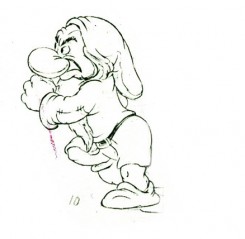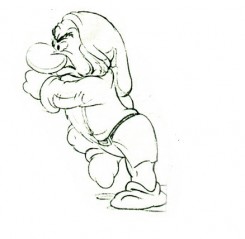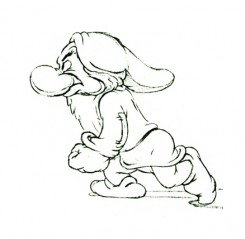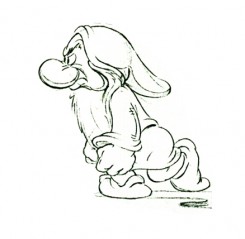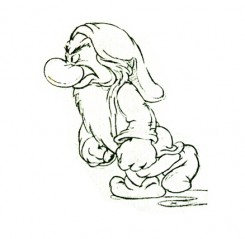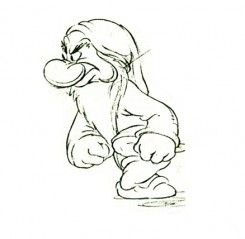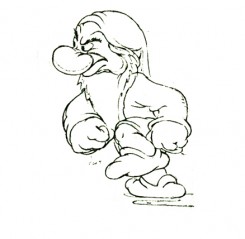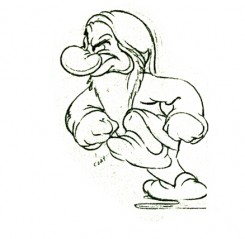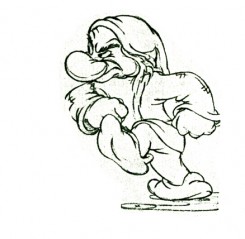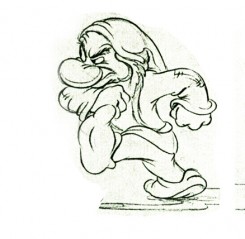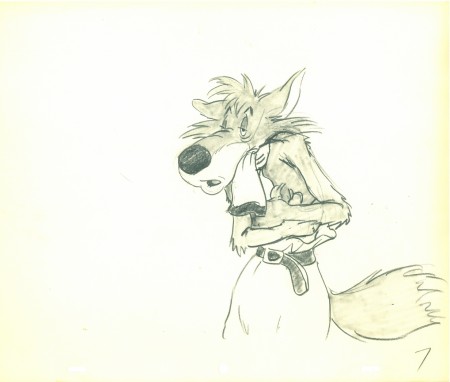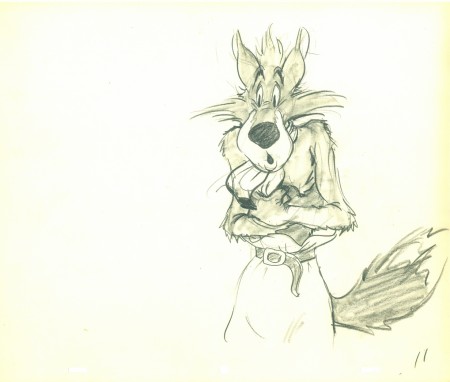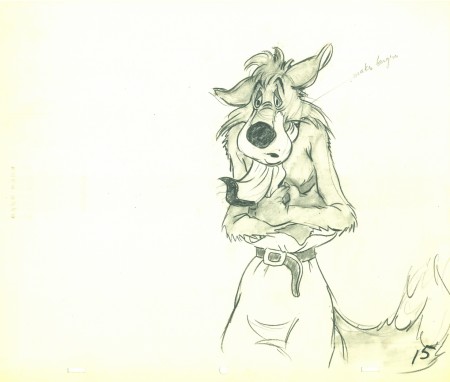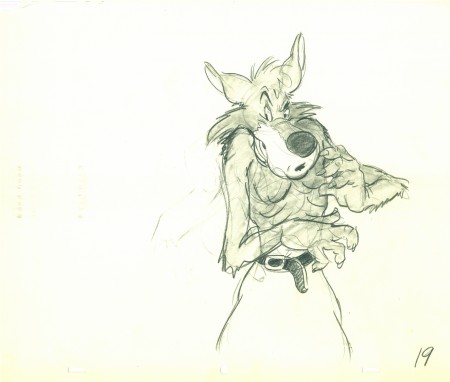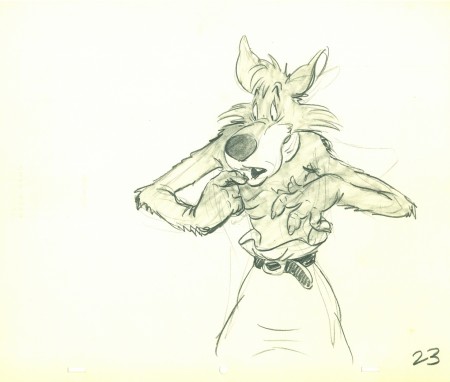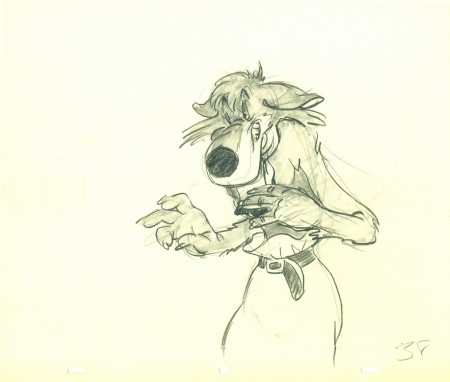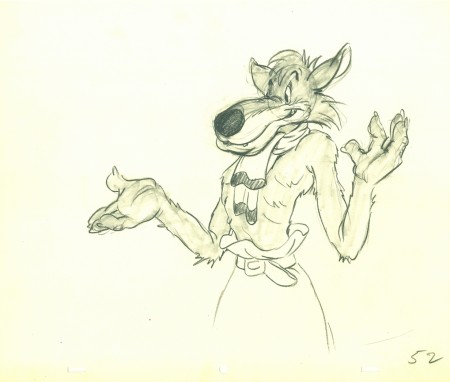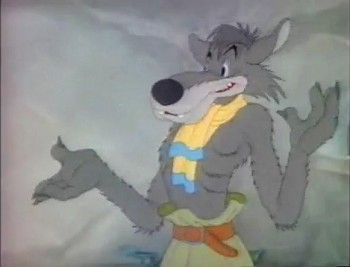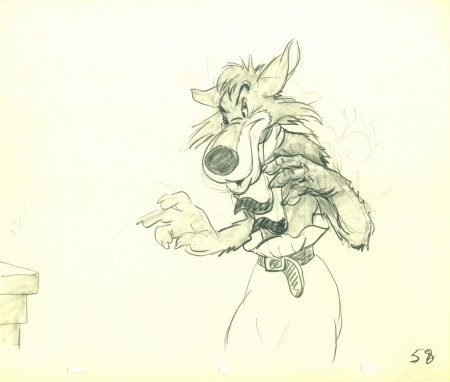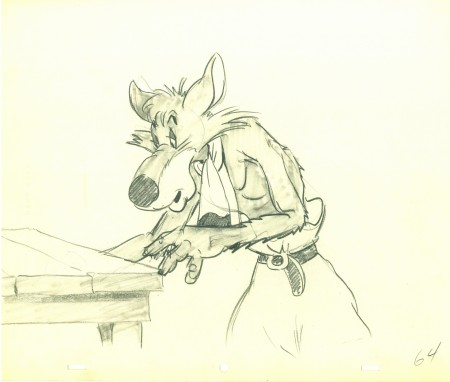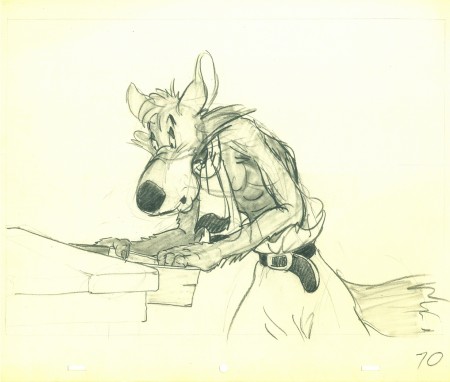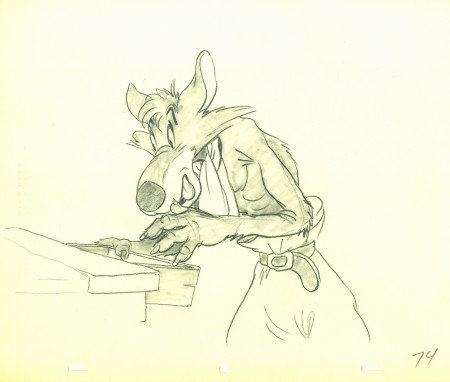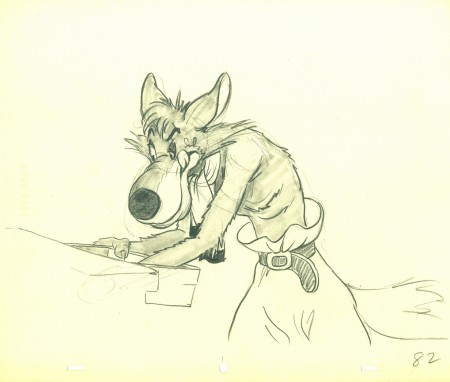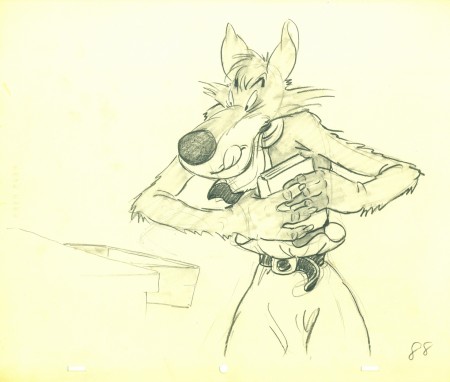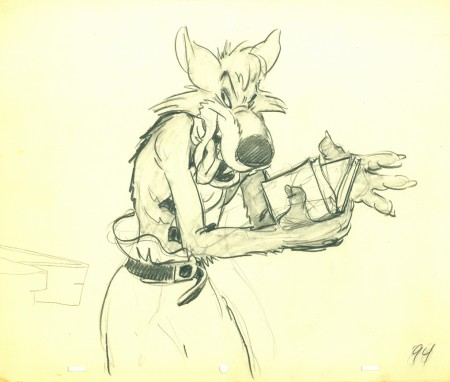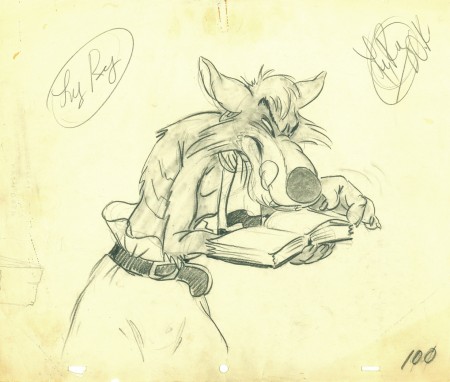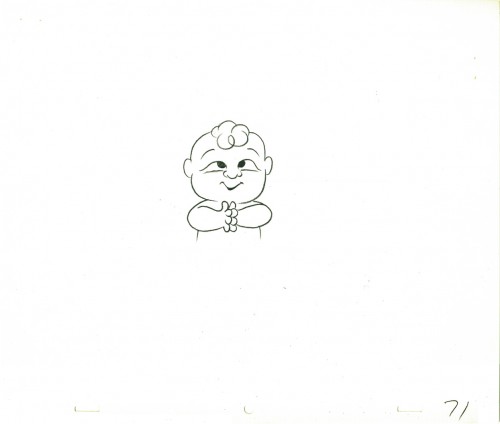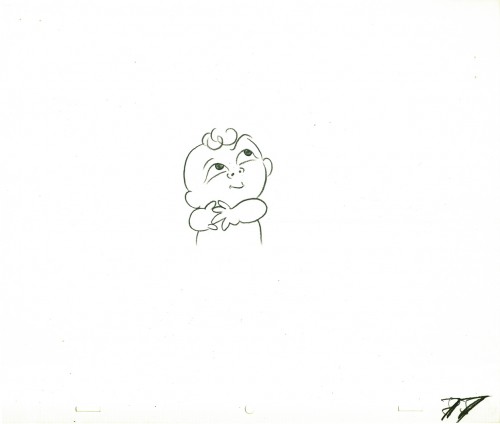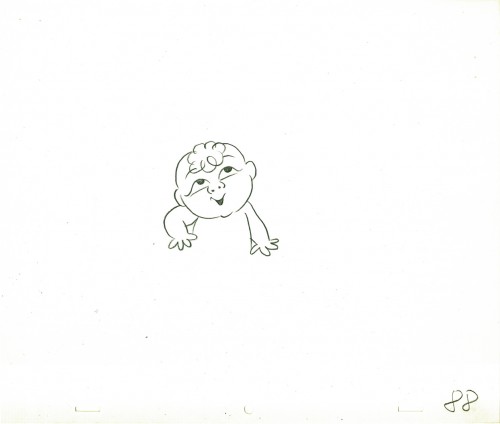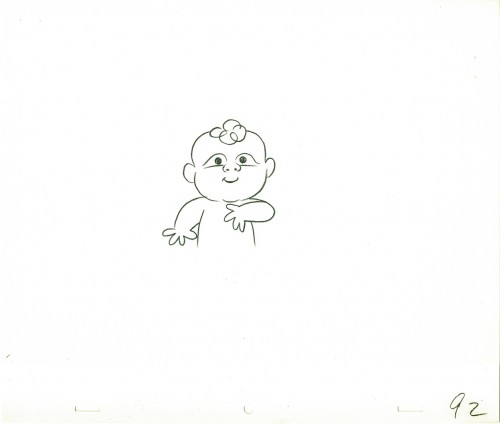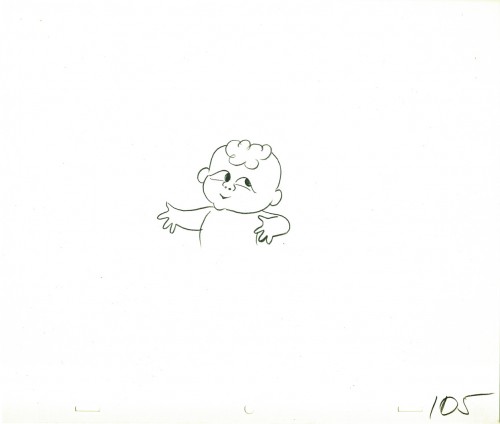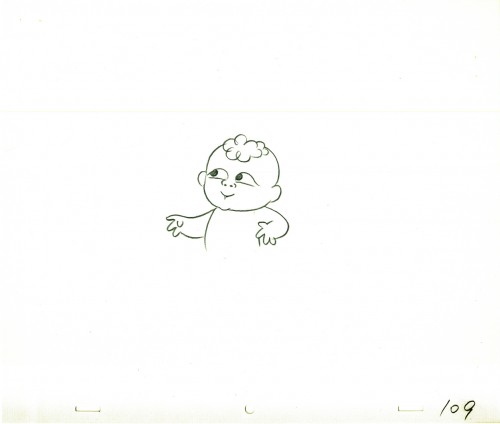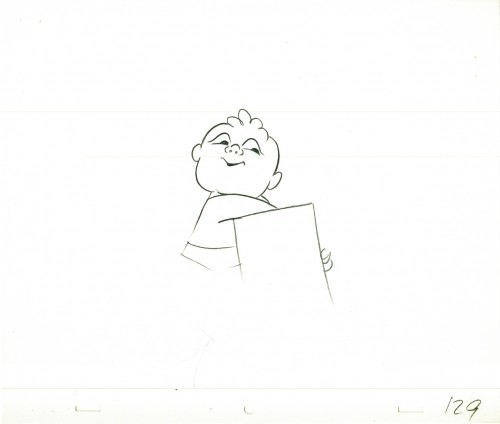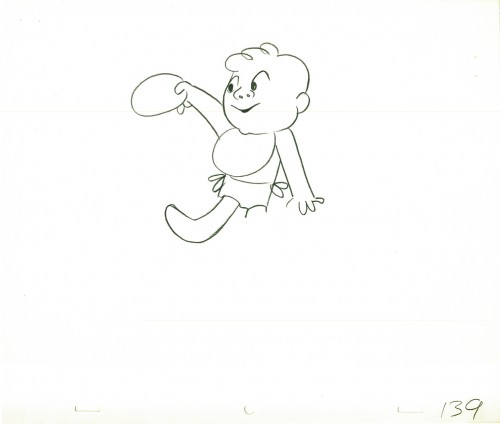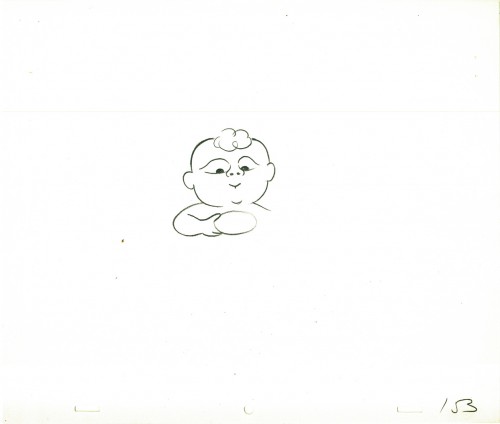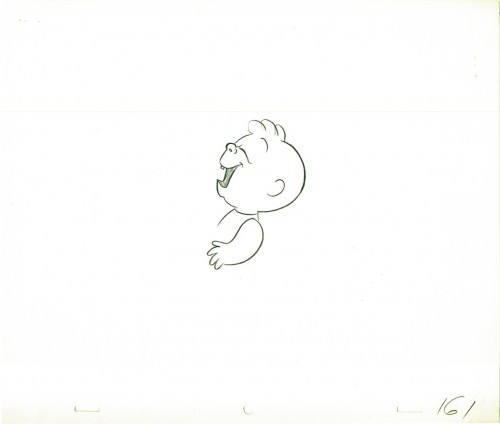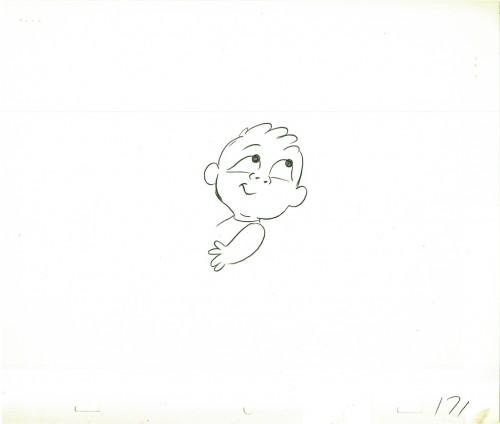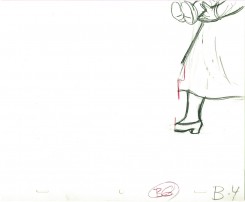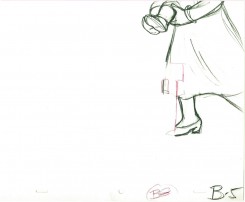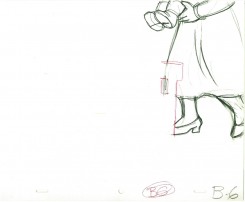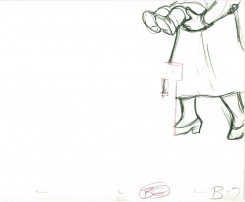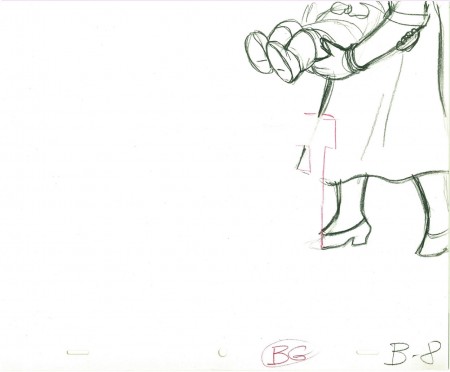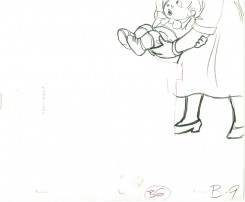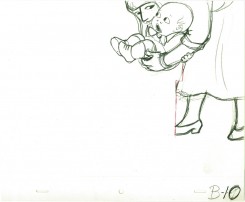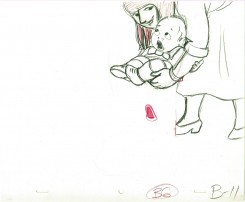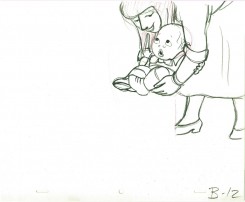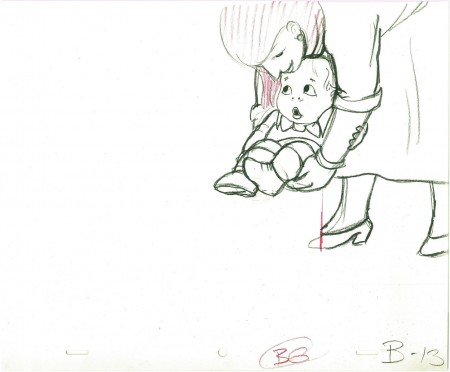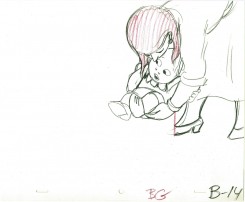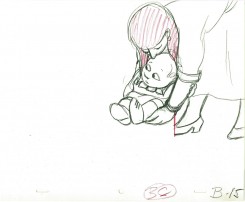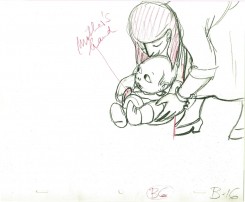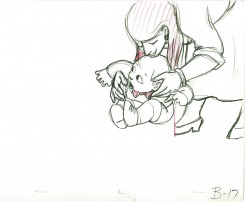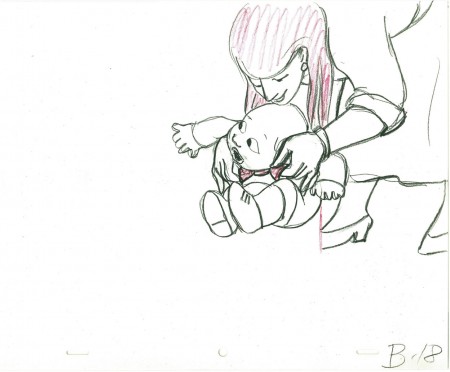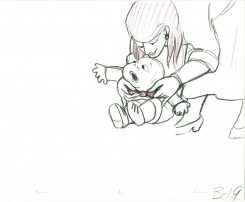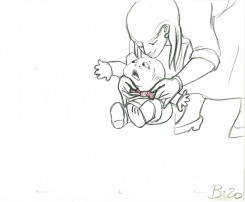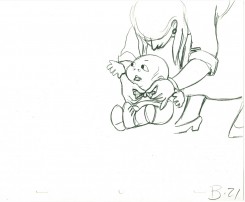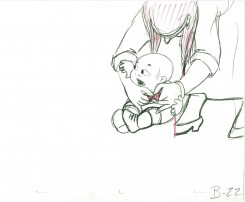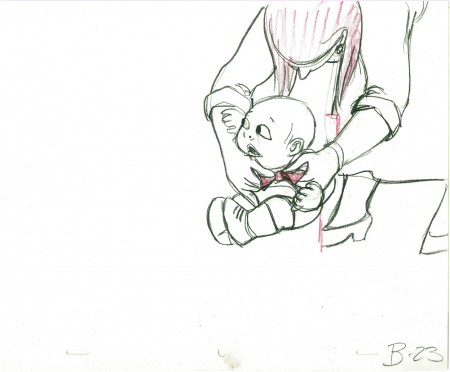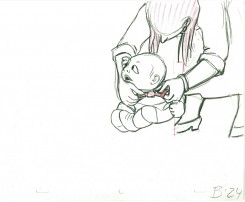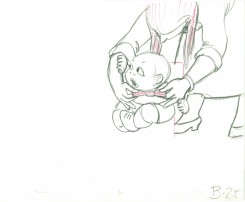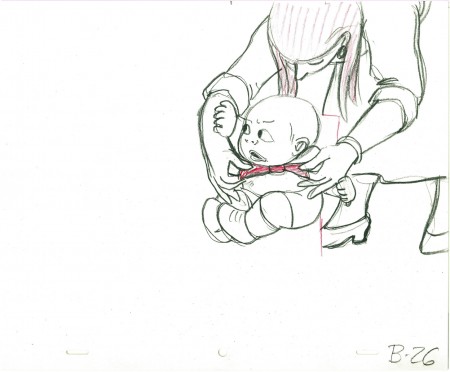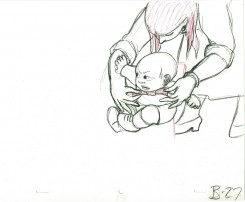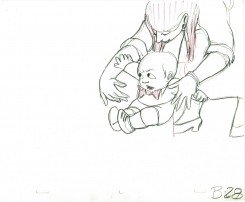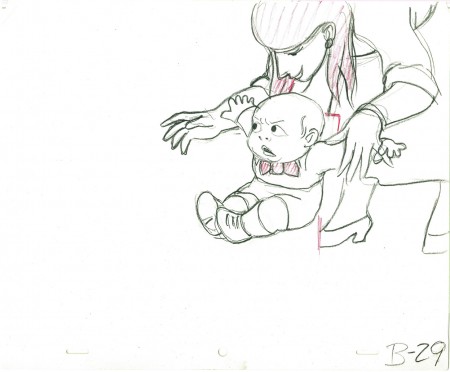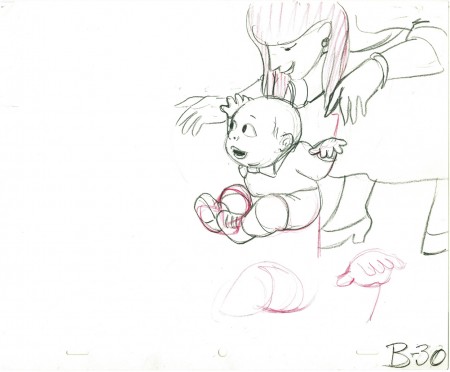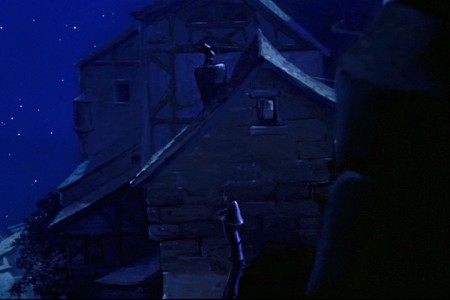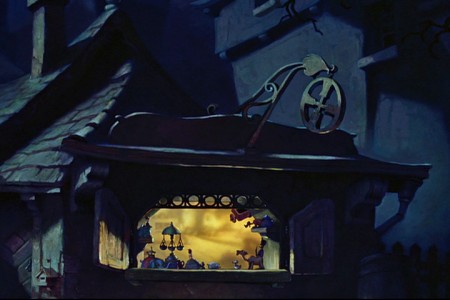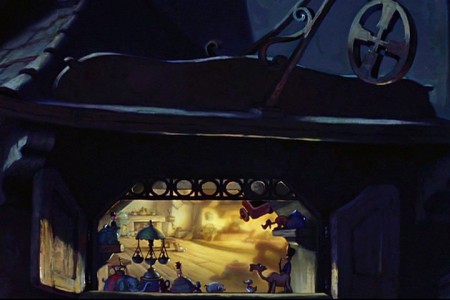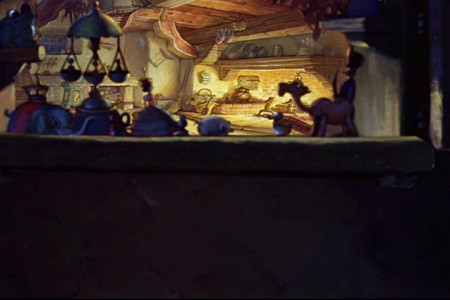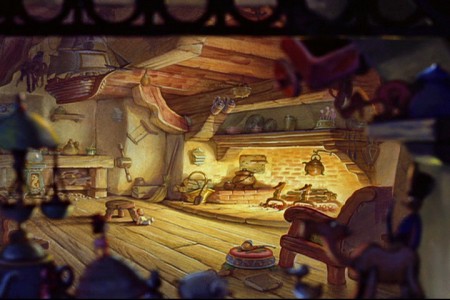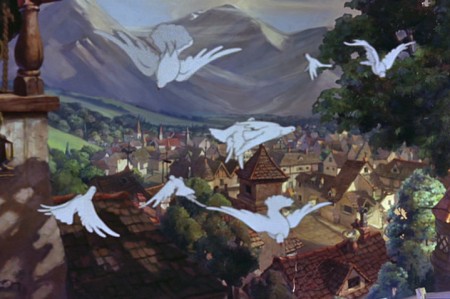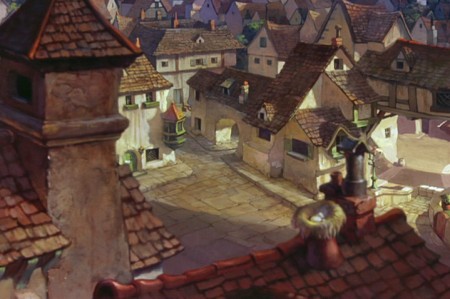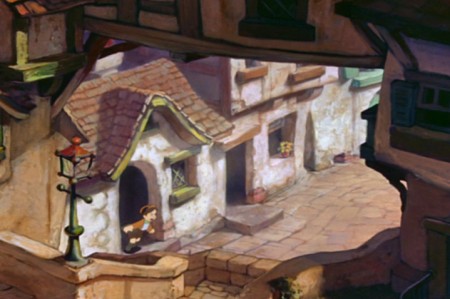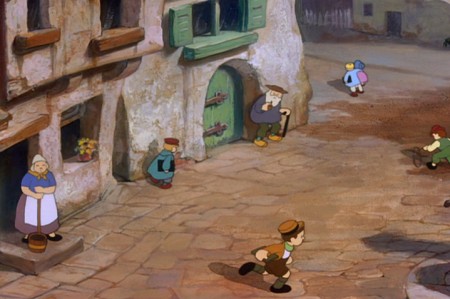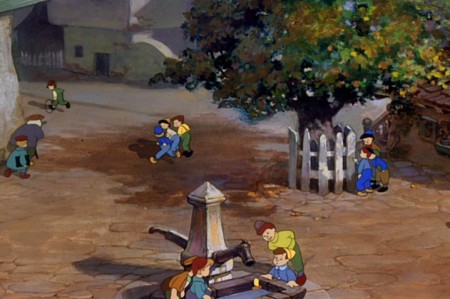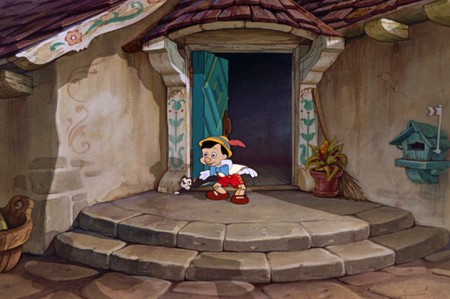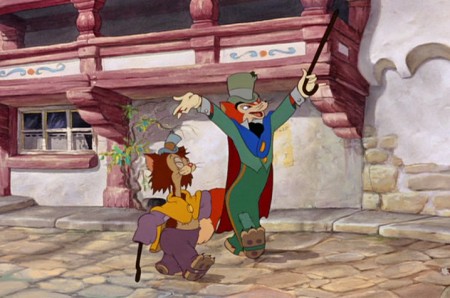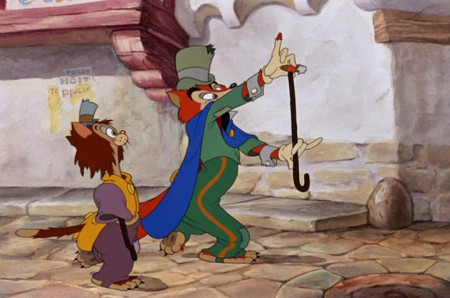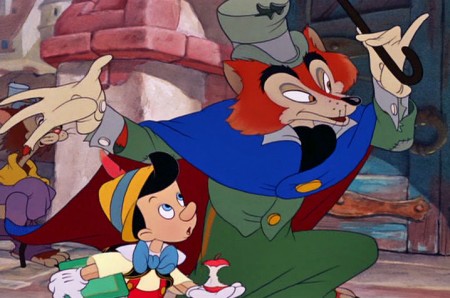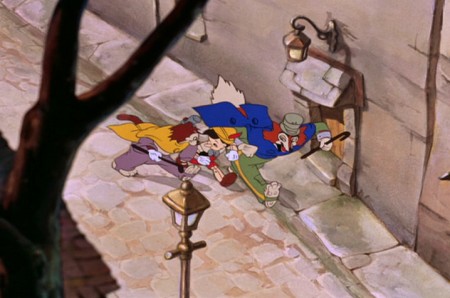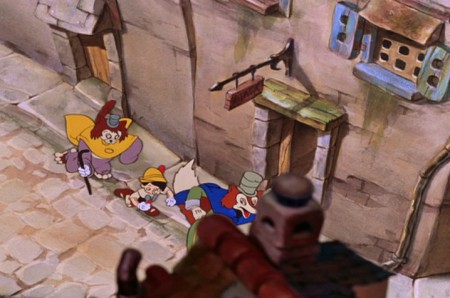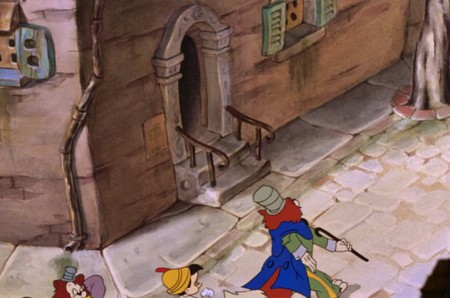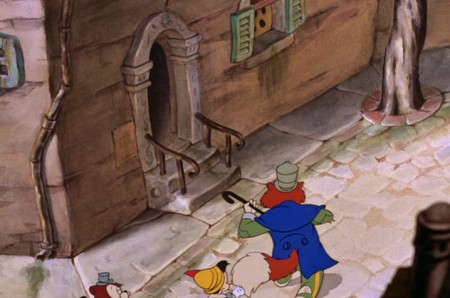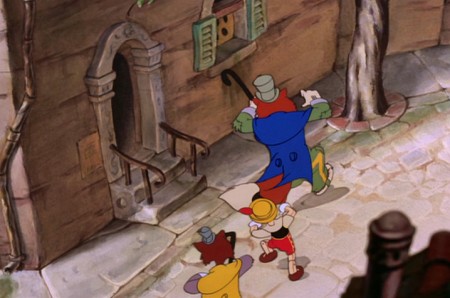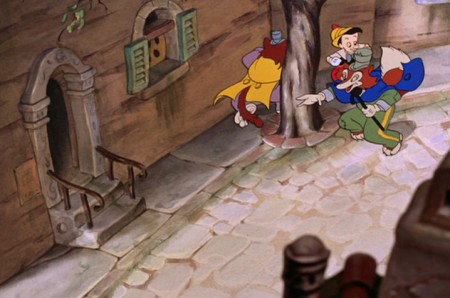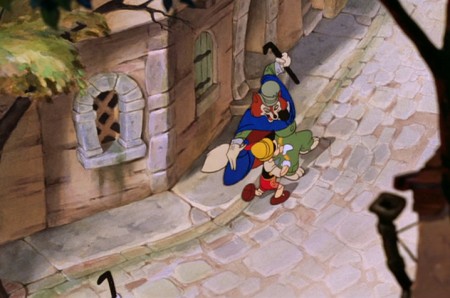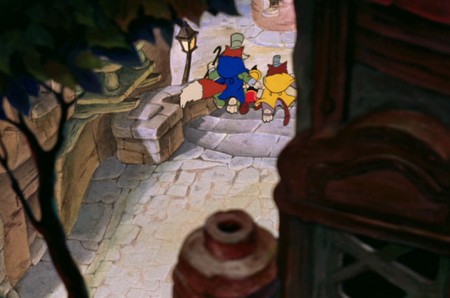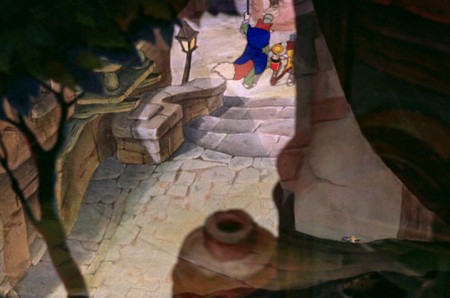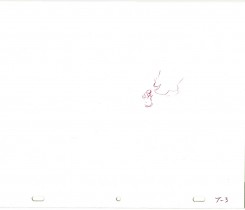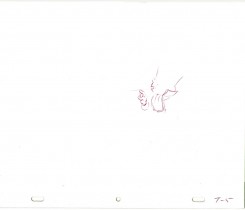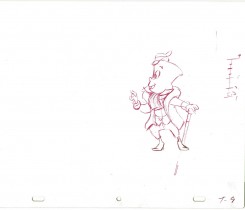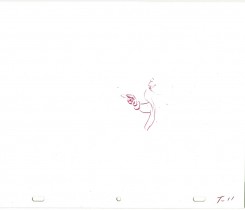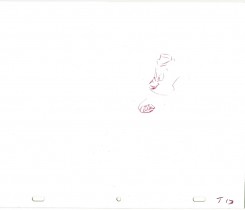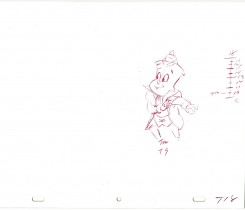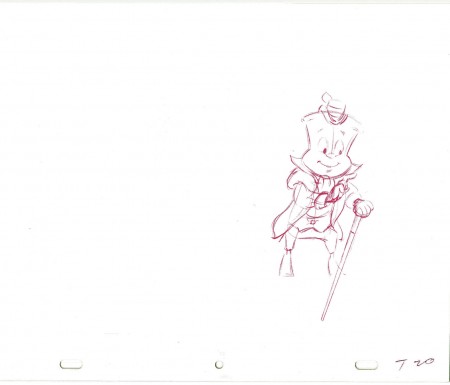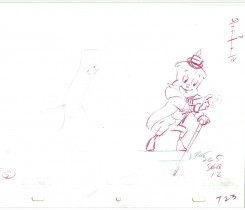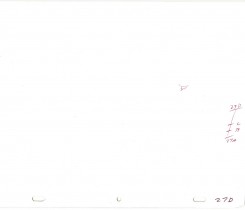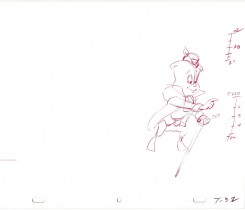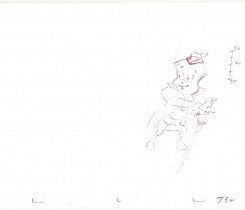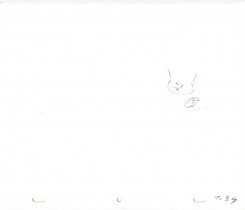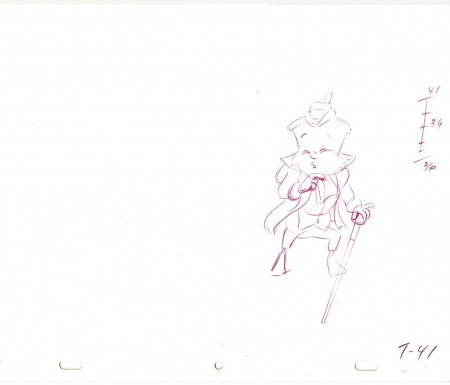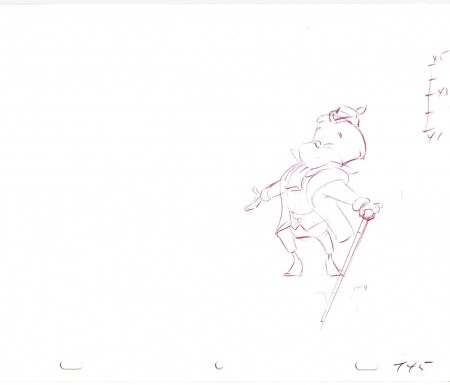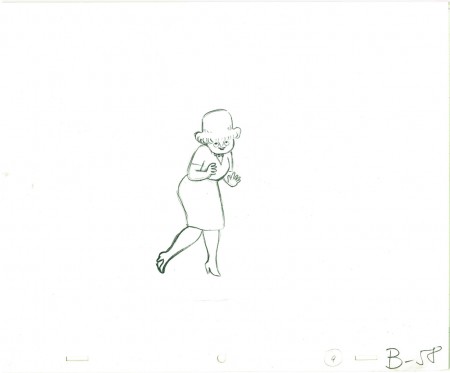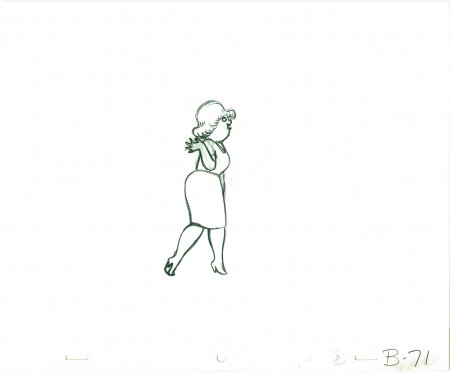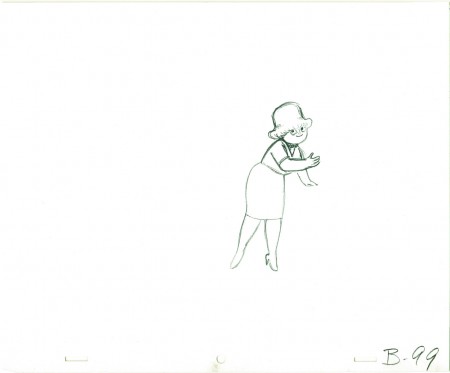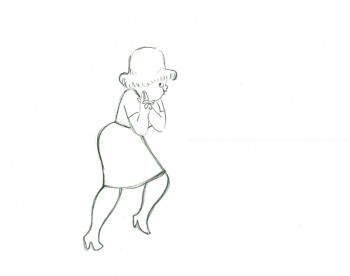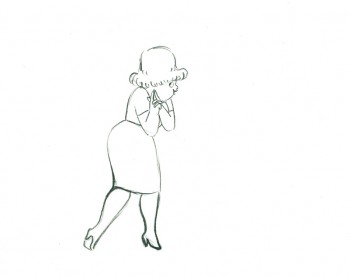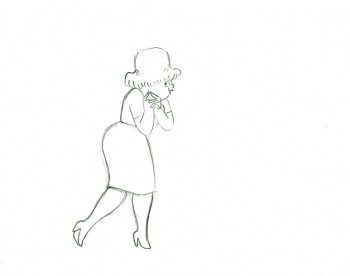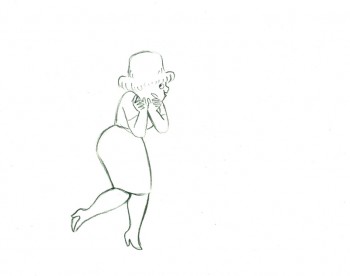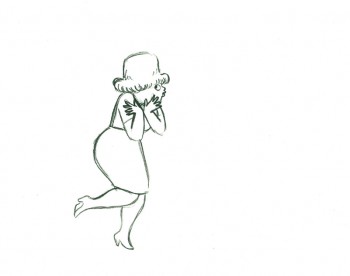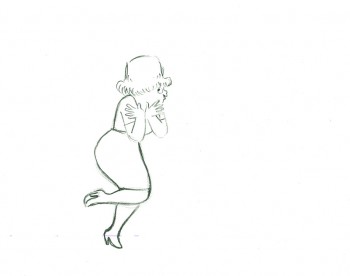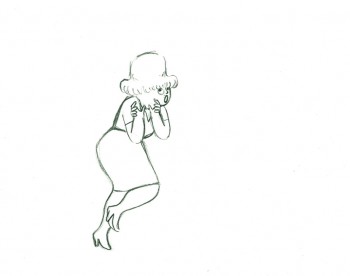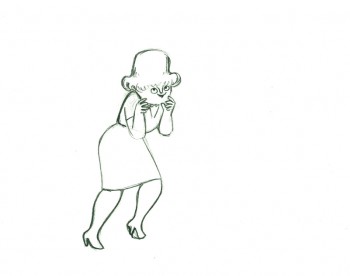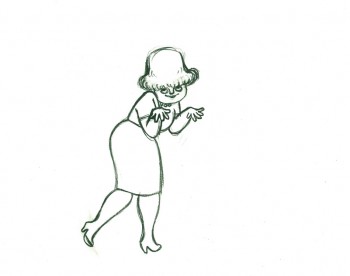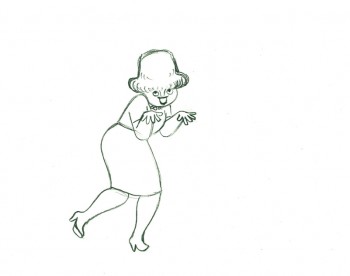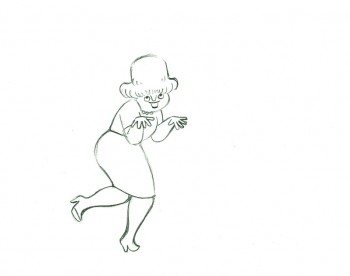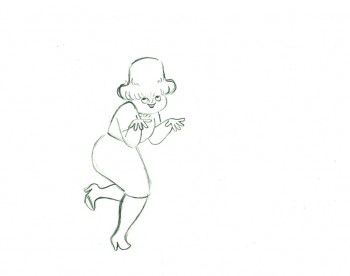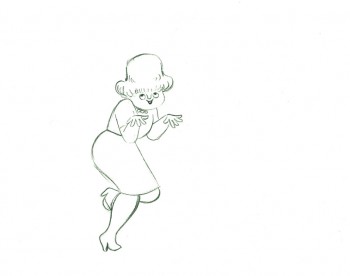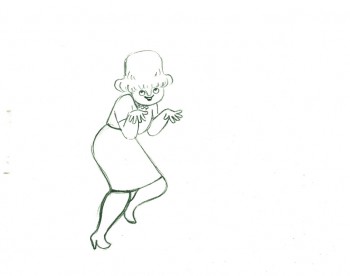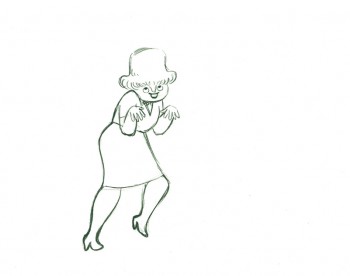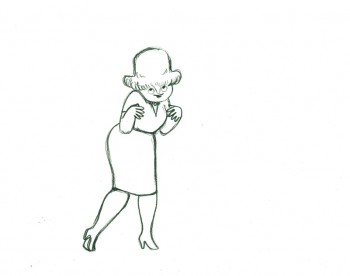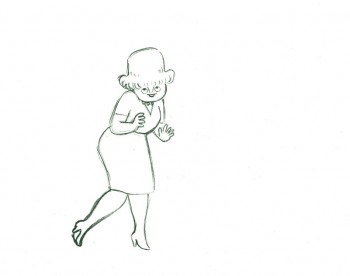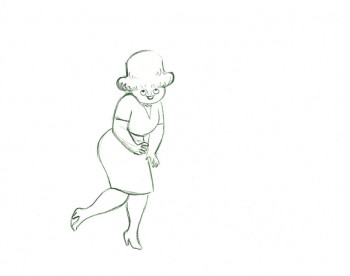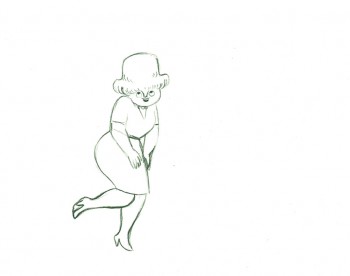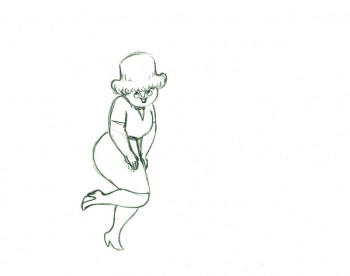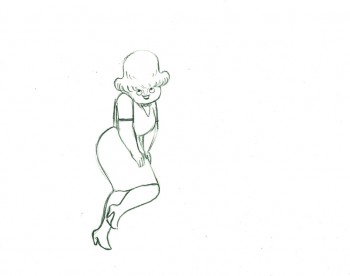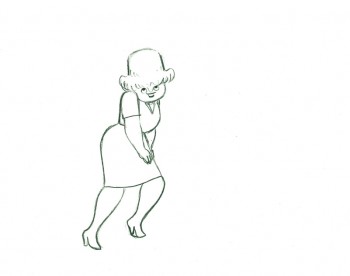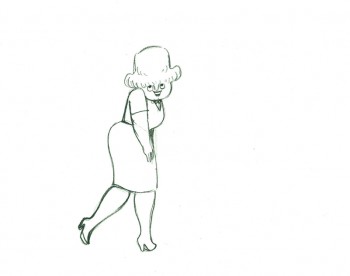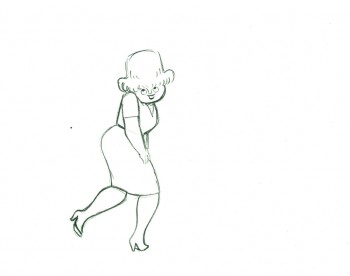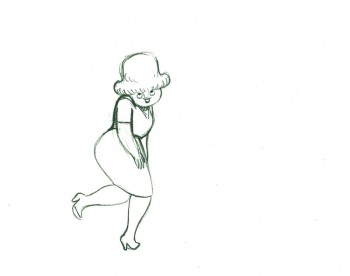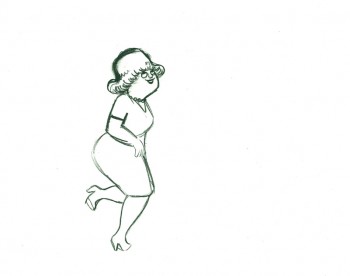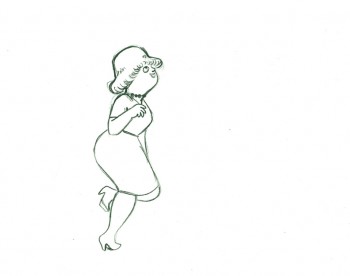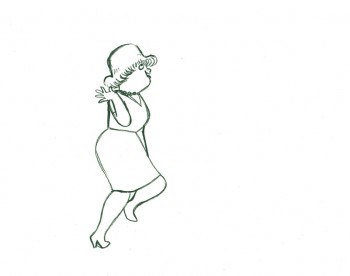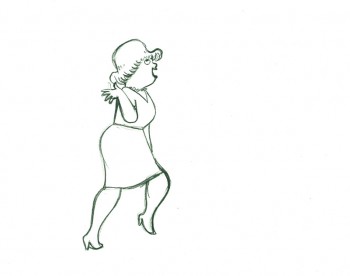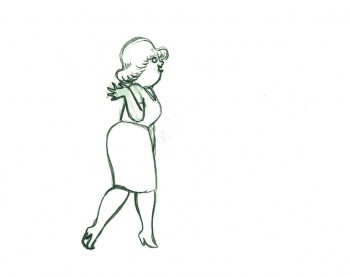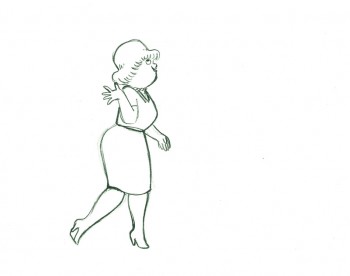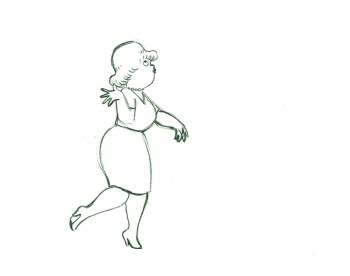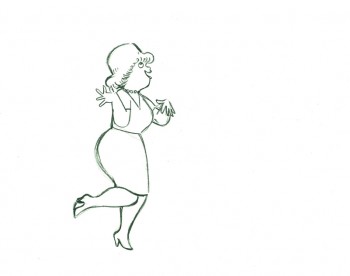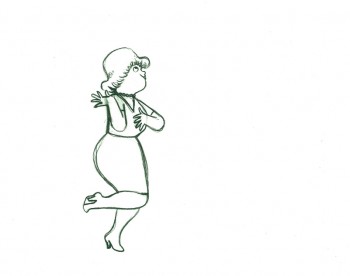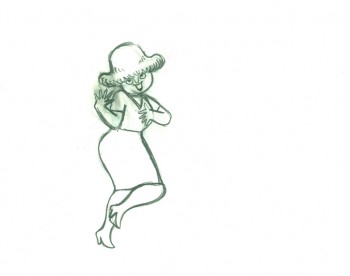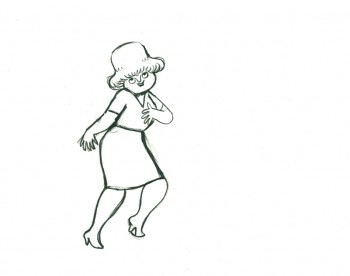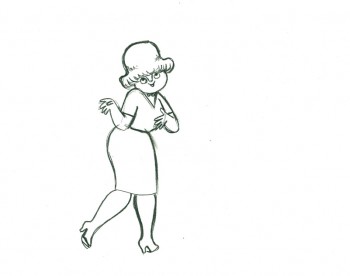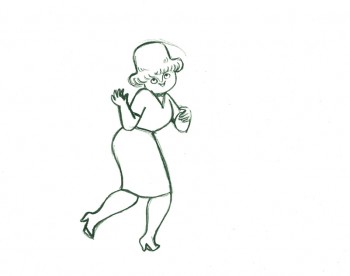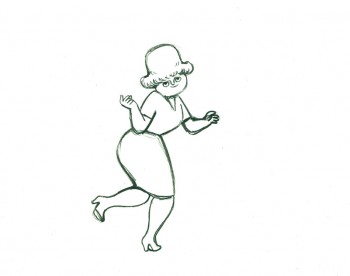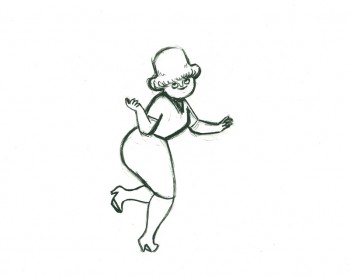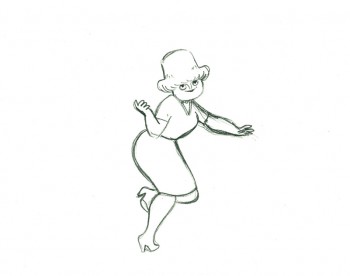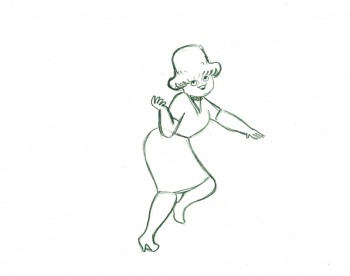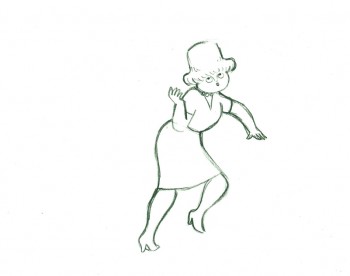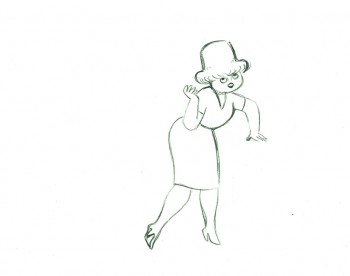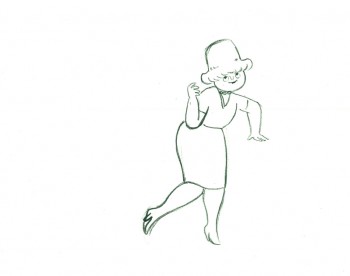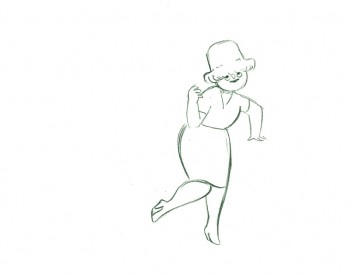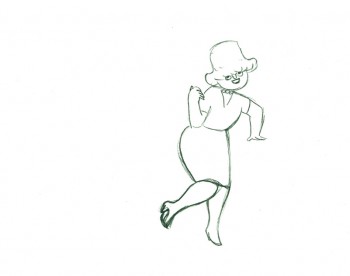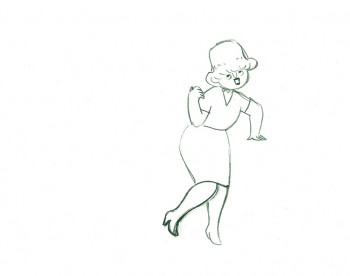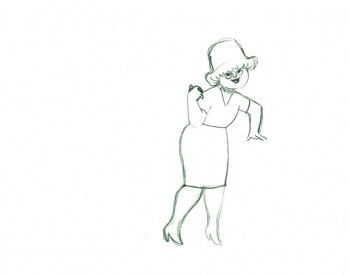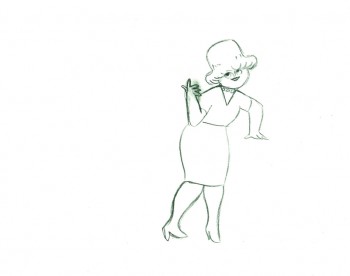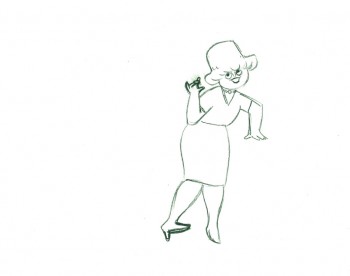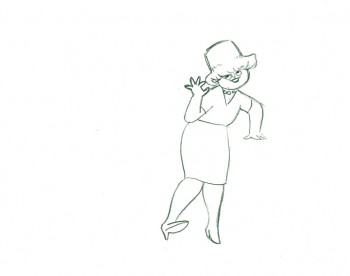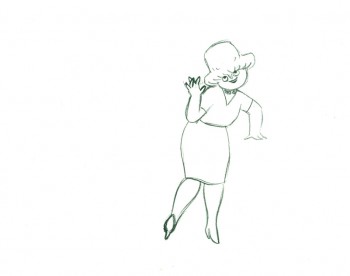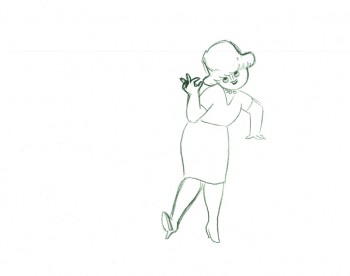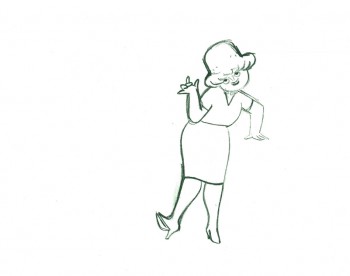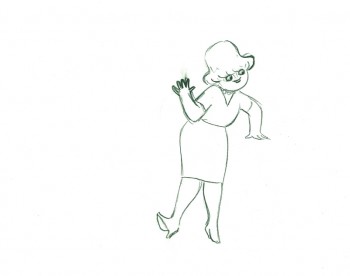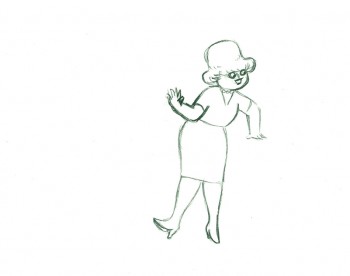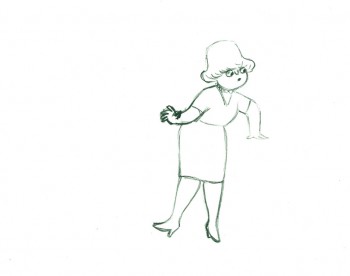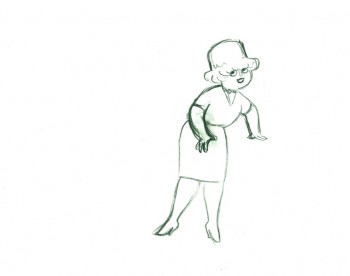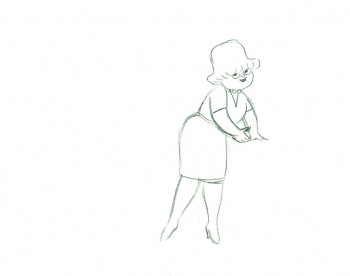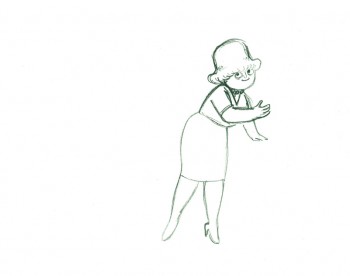Category ArchiveAnimation
Animation &Animation Artifacts &Disney 14 Jul 2011 07:18 am
Dwarf walk – recap
As I noted on Saturday last, I have a wealth of Bill Tytla animation on the past of this blog and I think it’s time to bring it forward for a recap. The stuff is too good and deserves more than a little study for ANYONE who calls himself an animator. This piece was originally posted in August 2009.
- Here are the drawings of Grumpy walking in a huff. Bill Tytla was the animator. The images come from a photostat which prepared the material for publication. A couple of these drawings appeared in the Thomas-Johnston book, Illusion of Life. The sequence, here, is missing drawing numbers 6,7 and 8.)
 1
1 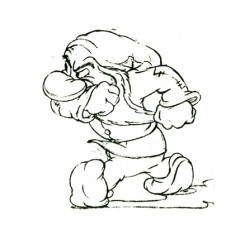 2
2Note how he starts with his shoulders high.
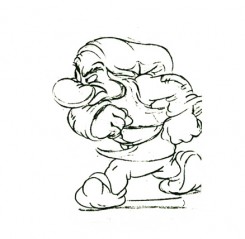 3
3 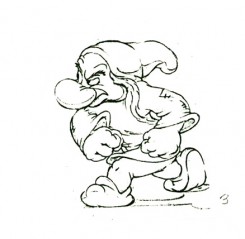 4
4
His bent leg, at this point, takes the weight of his body.
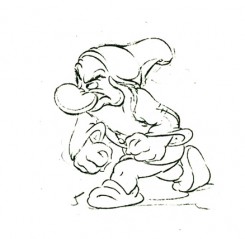 5
5 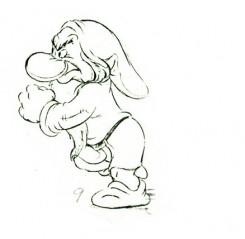 9
9
He moves his body up, high . . .
(Note that we’re missing drawings 6, 7, and 8.)
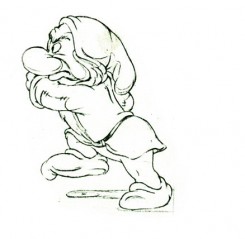 12
12 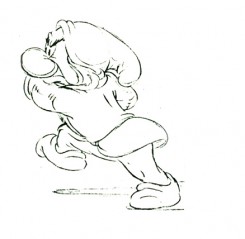 13
13
. . . then twists his entire torso.
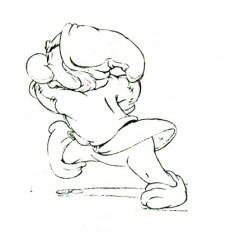 14
14 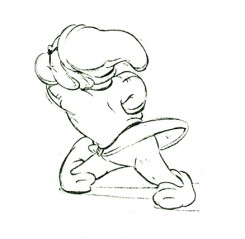 15
15
The straightened leg makes contact.
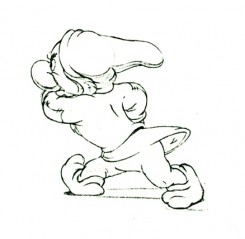 16
16 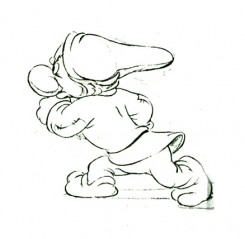 17
17
Again the shoulders go high as the pattern repeats on the other leg.
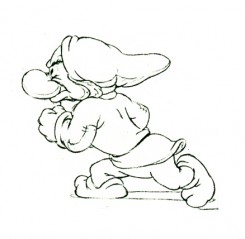 18
18 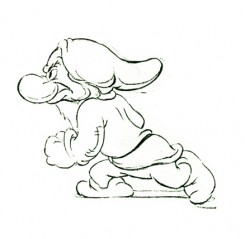 19
19
Note the detailed attention to the flow of the clothing throughout.
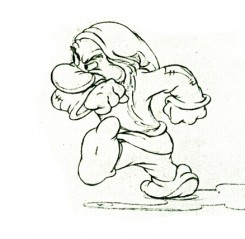 28
28
(Click any of the above images to enlarge.)
The following QT movie is on one’s with
the exception of dwngs #5, 9, & 11 on twos
to make up for the three missing drawings.
Right side to watch single frame.
Animation &Animation Artifacts &Disney &Tytla 13 Jul 2011 06:50 am
Tytla’s Dwarf Fight – recap
As I noted last Saturday, I intend to repost a number of the Bill Tytla animated pieces I have in the history of this blog. His work, at least to me, is too important to let just sit there. This post was originally published on this blog in March 2009.
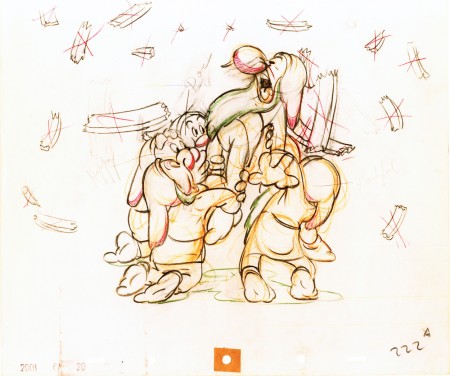
Here is a scene from Snow White, animated by Bill Tytla, in which four of the dwarfs fight Grumpy. The drawing above is the first of these drawings and it shows what it looked like in color – lots of red pencil notes, yellow pencil for rough structural lines. The rest of the drawings I have are B&W copies.
One of the things about Tytla’s work that I just love is the built in distortion he does to the characters. Check out Happy’s face (upper left) in drawing #227. Or Grumpy’s face in #260. They’re beautiful, and when the animation is moving, the distortion doesn’t show. He did as much with Stromboli. I’m convinced this is one of the ways he pulled the inner character out, trying to get Stanislavski’s theories into animation. It’s wonderful.
By the way, if you like this material check out Hans Perk ‘s site. Tytla talks about dealing with forces vs. forms in animation. This is what Tytla was all about in animating.
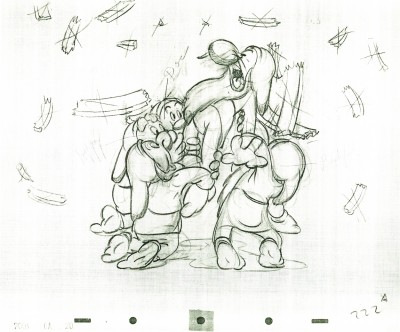 222
222(Click any image to enlarge.)
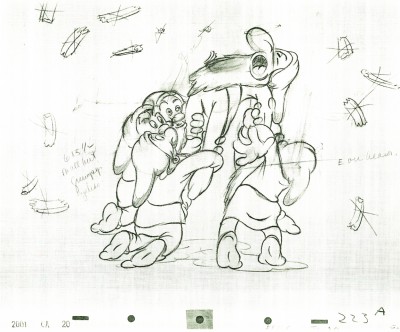 223
223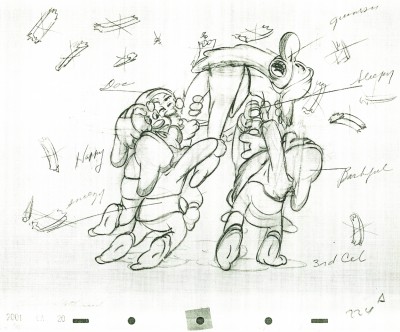 224
224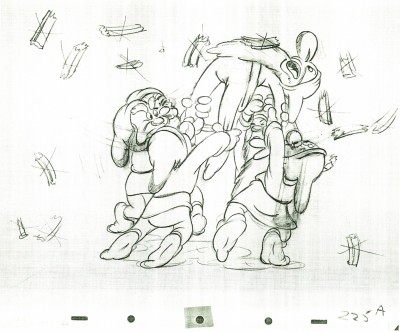 225
225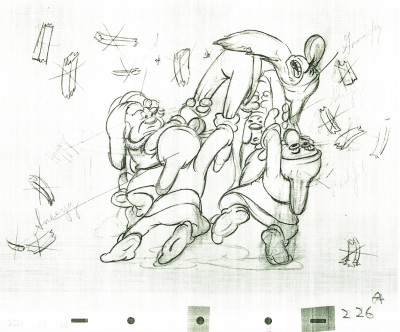 226
226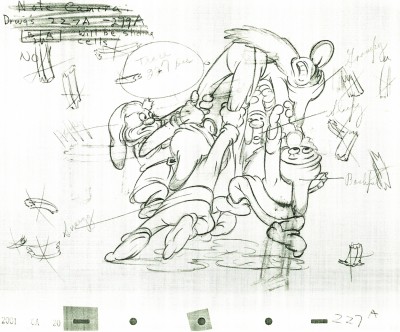 227
227Check out Happy’s face on this inbetween.
Then check out Tytla’s drawing (the next one) of Happy.
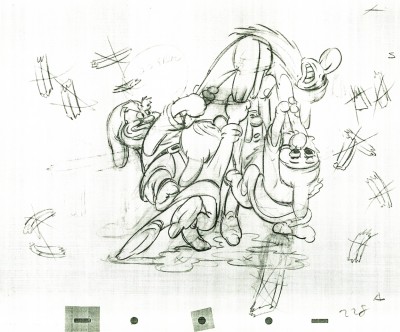 228
228
Tytla marked his own drawings with an “X” in the upper right corner.
The other drawings are the work of inbetweeners. The writing looks
to be all the work of Tytla.
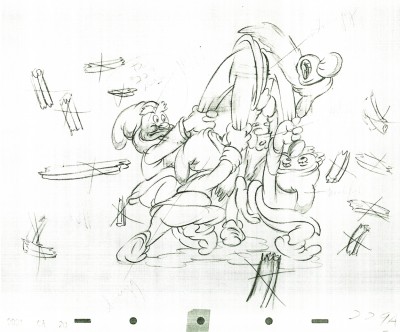 229
229
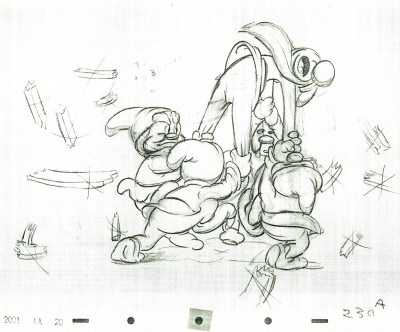 230
230
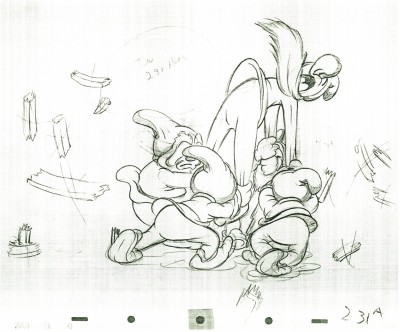 231
231
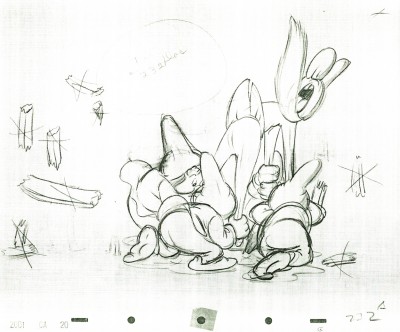 232
232
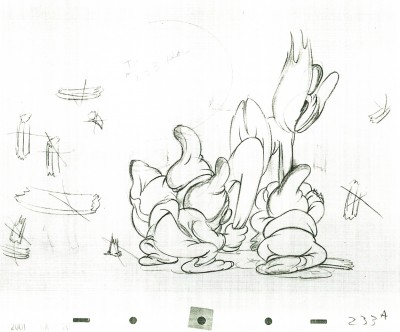 233
233
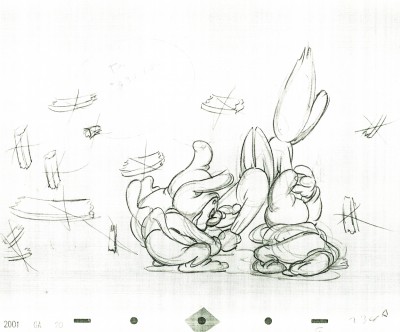 234
234
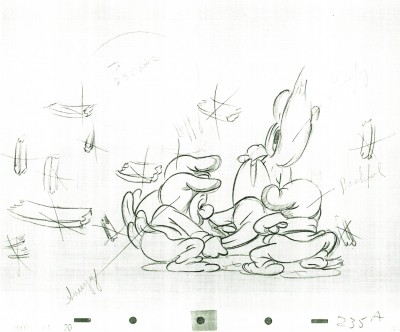 235
235
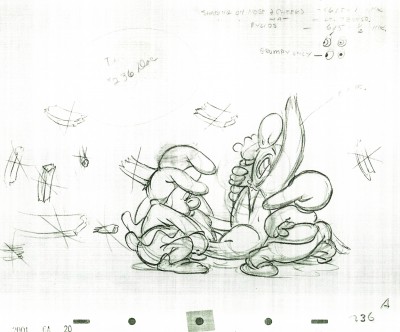 236
236
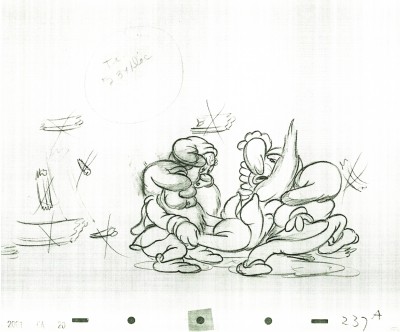 237
237
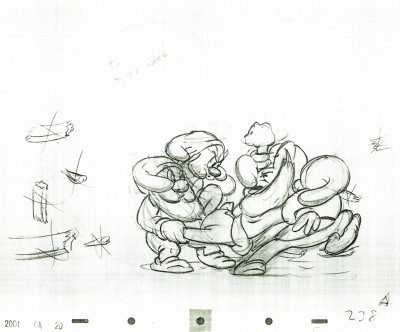 238
238
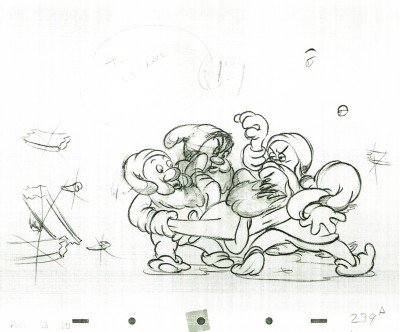 239
239
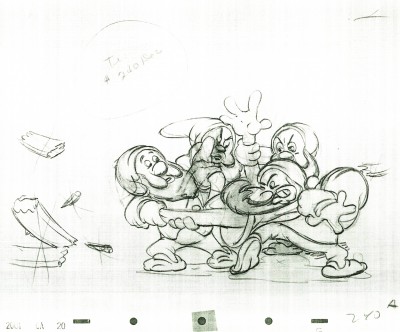 240
240
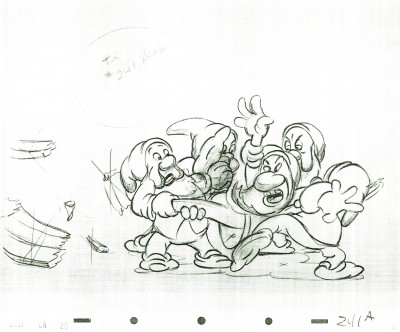 241
241
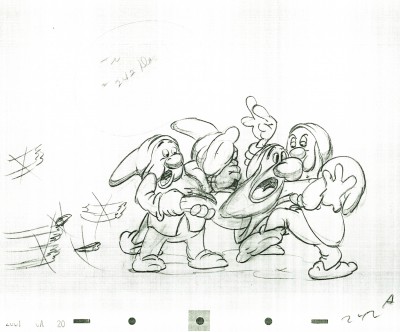 242
242
Some of these drawings are just hilarious in their own right.
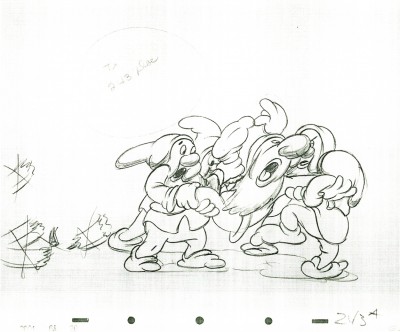 243
243
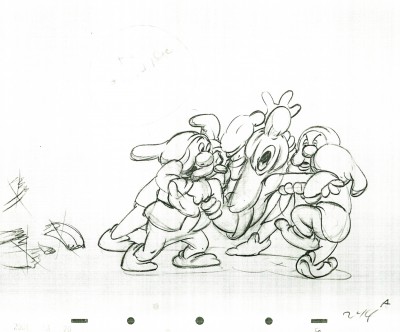 244
244
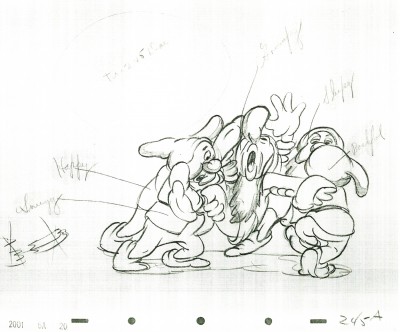 245
245
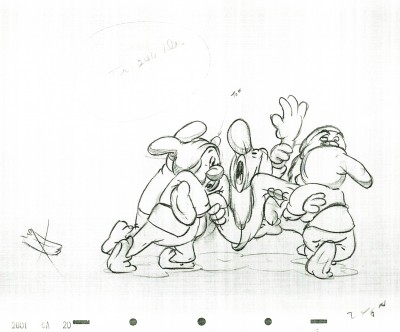 246
246
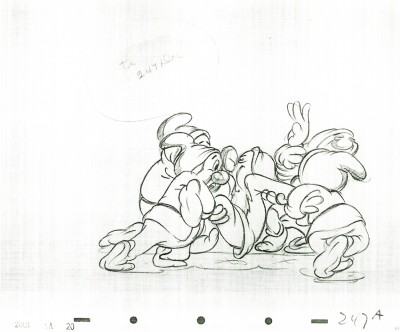 247
247
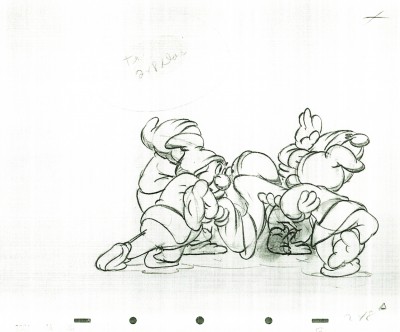 248
248
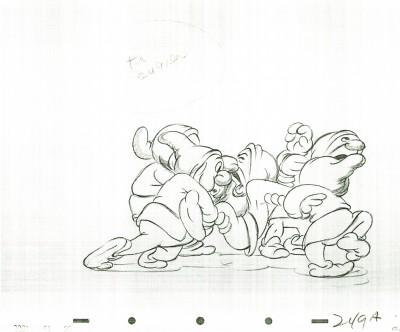 249
249
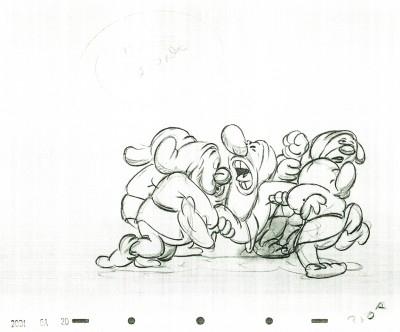 250
250
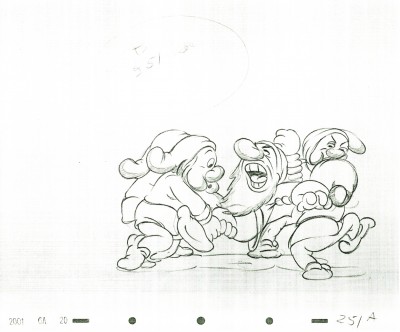 251
251
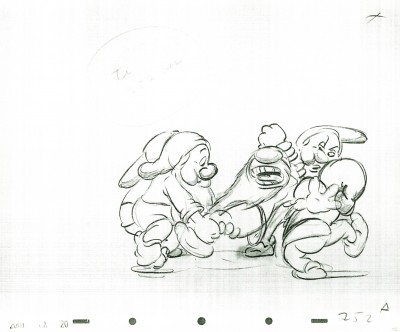 252
252
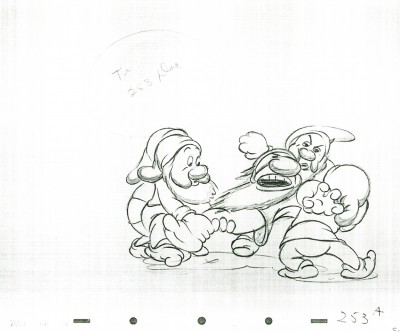 253
253
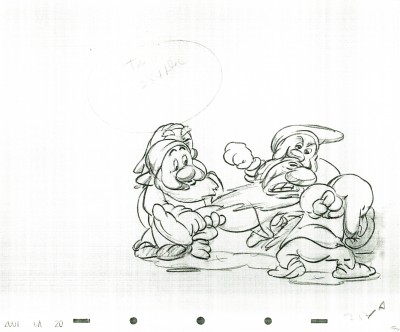 254
254
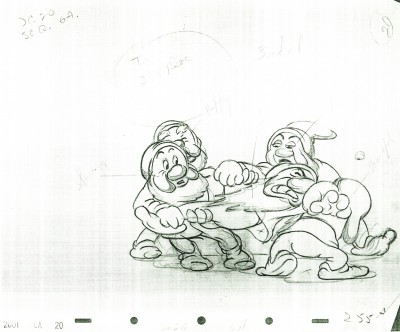 255
255
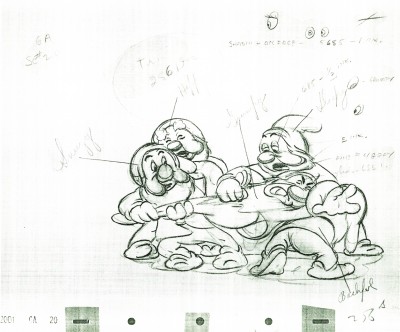 256
256
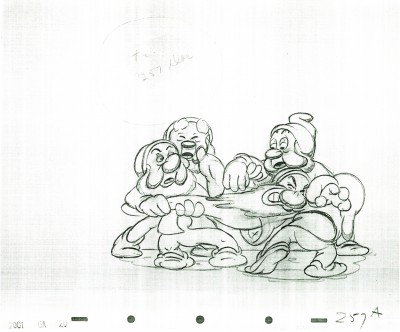 257
257
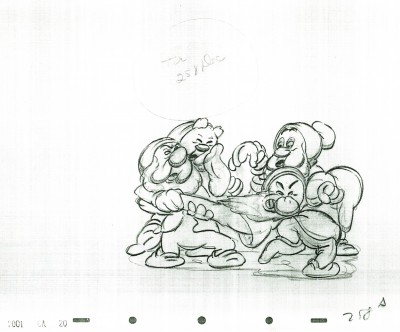 258
258
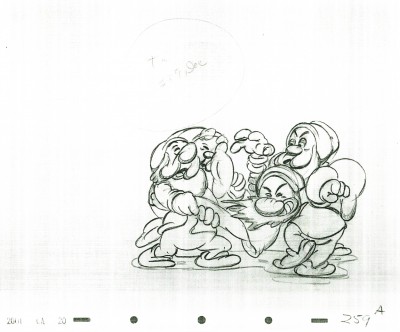 259
259
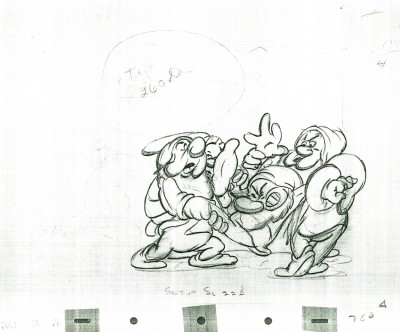 260
260
Animation &Books 09 Jul 2011 07:12 am
Tytla, Celestri, Anik and Eric Larsen
- Mark Sonntag just sent me a model sheet from The Hungry Wolf that he found on auction at Howard Lowery’s. There’s no way to tell if these drawings are by Tytla, but the drawing is beautiful just the same. The inclination to shade in the characters on this film is interesting, though. Many thanks to Mark for sharing.
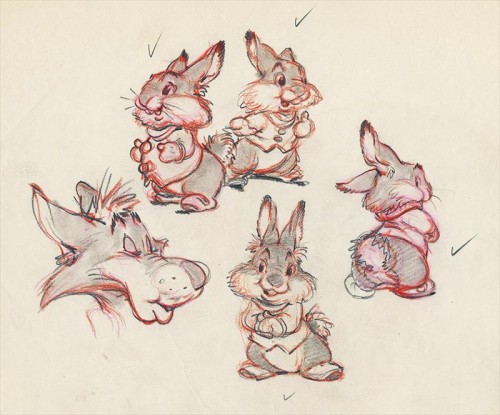
______________________________
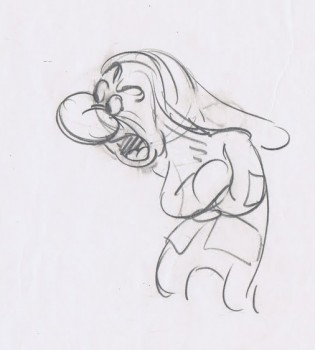 - I am such a fan of Bill Tytla‘s work, I can’t even begin to tell you how much. This week, on his blog, Andreas Deja posted some roughs by Tytla and I couldn’t believe how wonderful some of those drawings are.
- I am such a fan of Bill Tytla‘s work, I can’t even begin to tell you how much. This week, on his blog, Andreas Deja posted some roughs by Tytla and I couldn’t believe how wonderful some of those drawings are.
There’s a series of Grumpy posing in the middle of one of his negative rants, that just sends me. I’ve gone back to the blog at least a dozen times to look at those drawings again and again. The character starts by throwing all of his hostility out to whomever he’s talking to. Then he crosses his arms, with back to the listener. That immediately has him reach out to that person with his entire body, even though his arms stay crossed. It’s such a wonderful mix of emotions so beautifully and graphically presented. All the emotion within Grumpy is out on the floor; he thinks he has nothing to hide and is letting it all out. Thanks to Tytla, we see that Grumpy wants to be like all the others and love Snow White as well. He’s so conflicted and trying so hard not to be honest. This is a brilliant animator at the top of his game.
In the past, I’ve posted quite a few Tytla drawings – most of them loaned to me by John Canemaker. I think in the next week or two I’m going to pull out many of them for a recap. They’re just too great to sit hiding in the morgue of my blog. I want to take another look at them, and maybe share that, again, with you. I hope you’ll indulge my obsession.
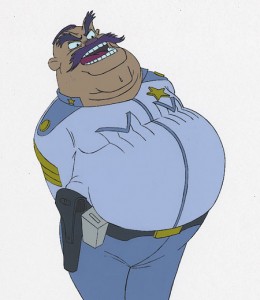 - John Celestri is a very good animator who has been a fan of Tytla’s work since I first met him back in 1977 on Raggedy Ann & Andy. John was in the NY Assistant pool that I supervised, and he was a talent to reckon with. Now, John has a new blog that is starting to take shape. It’s like many animator/director blogs in that it’s built around his work in the industry, and there’s a lot of experience for him to draw on. After he left Raggedy Ann, John moved onto Tubby the TUba at NYIT, then Nelvana to work on Rock & Rule. From there he worked on many features in LA, some with Richard Rich‘s studio for Nest Animation. In every step forward, John’s animation kept getting stronger. Now he has his own studio in Kentucky.
- John Celestri is a very good animator who has been a fan of Tytla’s work since I first met him back in 1977 on Raggedy Ann & Andy. John was in the NY Assistant pool that I supervised, and he was a talent to reckon with. Now, John has a new blog that is starting to take shape. It’s like many animator/director blogs in that it’s built around his work in the industry, and there’s a lot of experience for him to draw on. After he left Raggedy Ann, John moved onto Tubby the TUba at NYIT, then Nelvana to work on Rock & Rule. From there he worked on many features in LA, some with Richard Rich‘s studio for Nest Animation. In every step forward, John’s animation kept getting stronger. Now he has his own studio in Kentucky.
The blog, at present, uses John’s own work to show basic animation techniques and script writing problems. It’s growing up into something quite interesting, and I suggest you check it out, if you haven’t already.
By the way, I love that John has pursued a completely non-animation, secondary path in his life. He has also authored quite a few mystery novels with his wife, Cathie. (Their joint site is called CathieJohn.)
- Also worth visiting is the studio site for Dancing Line Productions. This is the animation company of Anik Rosenblum, a Vancouver, Canada animator who brings a lot of grace and lyricism to the animation he’s been doing for some beautiful spots. There are many examples of his work on the site, and you should take a look at some of it.
Below is an animated piece called “The Autumnal Walk” which gives a good idea of Anik’s work.
The Autumnal Walk
This is one of my favorite pages of Dancing Line’s site. It answers the question, “Why hire us?” Anik has a good, sweet sense of humor. More power to him; I hope his company is successful.
- I just read an interview with Eric Larsen in Don Peri‘s book, Working with Walt. Something Eric said caught me and I thought it would be good to quote him:
- When I came into this business, Frank [Thomas] and Ollie [Johnston] and Marc Davis and Ward Kimball and John Lounsbery all came about the same time. Hal King and a few more came then, too. There was a group of us who developed, and Walt started putting a certain’ amount of responsibility on us in a way. But we came through what we called me unit system: each one of us came up through a very strong animator. These are the men I spoke of a little while ago when I said that here were such great talents and yet they opened up their arms to you to let you have everything they had: Ham Luske, Norm Ferguson, Bill Roberts, Wilfred Jackson, Ben Sharpsteen, Freddy Moore, and then just a little bit later Bill Tytla. Good gosh, what more could you ask for! We came up under those men, being taught, you might say, with them looking over our shoulders. A number of years ago, we dissolved the unit system. Don’t ask me why because I can’t answer. It’s the biggest mistake we made. Now we are trying to set up units again. Like on Bambi, I had ten animators plus all their assistants
working with me. I spent most of my time up here in this room and then would go down and animate at night. But you could keep control of certain things. You learn by working with somebody who has gone I tough the mill. But you’re always learning. There’s no such thing as I graduation in an animation class.
Basically, Eric Larsen is saying that only by our working together can we advance the art of Animation. That’s true. But I wonder if we do that anymore. I wonder if we’re open to each other to try to help out. I hope so. I hope all these new sites, such as John Celestri’s site, help to impart some tidbit of knowledge to someone coming up. It’d be great if it does.
Animation &Animation Artifacts &Tytla 05 Jul 2011 11:28 pm
Tytla’s Hungry Wolf
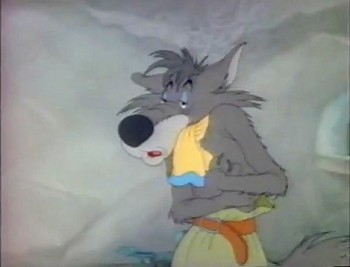 - Well, John Canemaker visited with a surprise. He brought a Bill Tytla scene. But this wasn’t Disney or Terry or Paramount. It was from a Hugh Harman film, The Hungry Wolf, made in 1940 at MGM. Not a very good film, the drawings are signed by Tytla, but they have no ladder indication for an Asst. to do the inbetweens. And most oddly, the wolves are shaded in by Tytla. Also take note of the table being animated into place. Are these animation drawings? Is it LO posing for someone else? And biggest of all, what is Tytla doing at MGM?
- Well, John Canemaker visited with a surprise. He brought a Bill Tytla scene. But this wasn’t Disney or Terry or Paramount. It was from a Hugh Harman film, The Hungry Wolf, made in 1940 at MGM. Not a very good film, the drawings are signed by Tytla, but they have no ladder indication for an Asst. to do the inbetweens. And most oddly, the wolves are shaded in by Tytla. Also take note of the table being animated into place. Are these animation drawings? Is it LO posing for someone else? And biggest of all, what is Tytla doing at MGM?
Since this would have been completed in early 1942, I can only assume that it was during the strike at Disney that Tytla did some work for Harman in mid 1941. Perhaps he came on as an animation director under Harman, who got credit for directing.
Here are all the drawings.
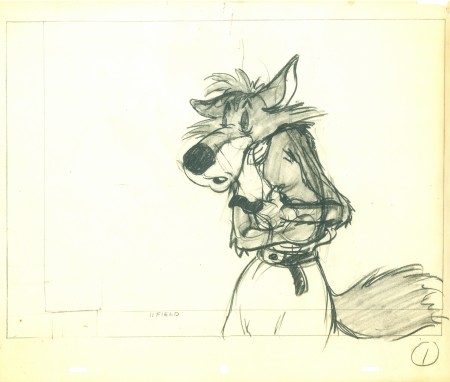 1
________________________
1
________________________.
The following is a QT of the entire scene with all the drawings included.
Since I didn’t have exposure sheets, I calculated everything on ones
(which seems to reflect the timing in the final film) and left however many
Many thanks to John Canemaker for the loan of the drawings. It was great just touching them.
Animation &Animation Artifacts &commercial animation 29 Jun 2011 07:17 am
Tissa Baby Spot
- Here are some drawings of another baby drawn by Tissa David for a commercial done for Robert Lawrence Animation. I’m not sure what the product is, but the baby obviously is happy about it, whatever it is.
These drawings were not used in the final spot. Tissa reanimated it, but I thought they were impressive enought to post. She did both animation and cleanup.
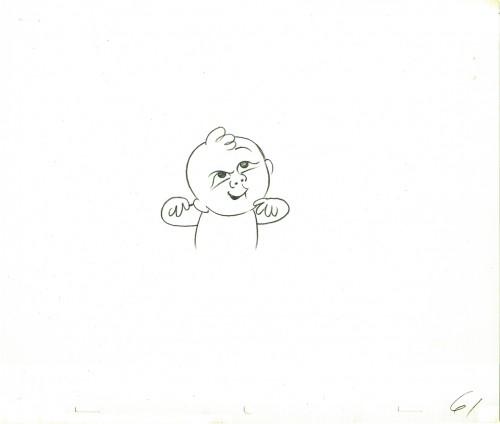 61
________________________
61
________________________.
The following is a QT of the entire scene with all the drawings included.
Since I didn’t have exposure sheets, I calculated everything on twos and
left however many frames between drawings with 4 fr. dissolves between them.
I don’t know if there were any holds, but I suspect there were.
Animation &Animation Artifacts &Hubley &Tissa David 22 Jun 2011 07:22 am
Tissa’s Baby
- Here’s the first part of a scene Tissa David animated for the Hubley feature EVERYBODY RIDES THE CAROUSEL. The baby is one year old and mother puts him down in front of the lit birthday cake. She tries to fix his tie, but he’ll have none of it. I have the mother drawings that follow this, but I’m missing the baby. So I’ll let it end at this point.
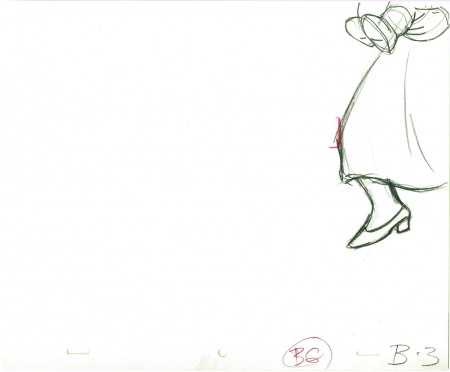 3
3
________________________
.
The following is a QT of the entire scene with all the drawings included.
Since I didn’t have exposure sheets, I calculated everything on threes
since Tissa did a lot of her Hubley work on threes.
I don’t know if there were any holds, but I doubt it.
Animation &Independent Animation 21 Jun 2011 07:04 am
Kathy Rose – Filmmaker/Performance Artist
- Kathy Rose has had a long and esteemed career doing personal animation. She made her name, at first, with the animation style she began at CalArts and continued on into the 70′s with her gem of a film, PENCIL BOOKLINGS. She took a 90° turn combining her animation with her dance and performance art via her 1983 piece, PRIMITIVE MOVERS. Since then she has developed this very personal and individual art form with many more theatrical pieces and video pieces.
I had a close eye on Kathy’s original animated films, but have lost track of the performance works. It was with some excitement and interest that I contacted her to ask several questions about her more current work and have been pleased for the chance to catch up – a little bit.
Q. To begin with, can you tell us about your beginnings; why you gravitated toward animation in the first place, and what steps you took?
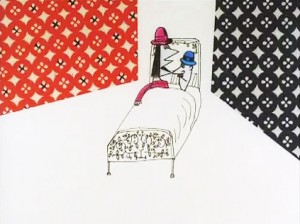 I was a film major at the Philadelphia College of Art, and while there, I saw the animation of Yoji Kuri, specifically – his film Ai (pictured right). I was totally enchanted with his work. That and an interest in photography and collage led me to animation. My thesis project was a live action film, called Portraits, but included pixilation and some cut out animation which I projected onto a live face in the film. The project was a series of portraits of friends, the
I was a film major at the Philadelphia College of Art, and while there, I saw the animation of Yoji Kuri, specifically – his film Ai (pictured right). I was totally enchanted with his work. That and an interest in photography and collage led me to animation. My thesis project was a live action film, called Portraits, but included pixilation and some cut out animation which I projected onto a live face in the film. The project was a series of portraits of friends, the
last – a self portrait – included excerpts of the other pieces, and finally this projection, all signifying our projection of others into our self image.
I also was training in dance and performing with a multi-media group in Philadelphia called Group Motion, started by former students of the great German expressionist dancer Mary Wigman. This experience would have an enormous impact on me in the coming years.”
When I left PCA, in 1971 I started to teach myself animation. My father – who was a photographer – gave me $1000 as a graduation gift to make an animated film. I did several explorations, using drawing pads to create the animation. Movers (on my site) was the last piece I made in that series before going to Cal Arts.
Q. You graduated from CalArts in 1974 with a class that produced a number of important non-linear filmmakers, such as Adam Beckett, Dennis Pies, Joyce Borenstein and yourself, who turned Independent animation on its ear. Can you tell us a bit about those years; was there a particular influence on you all?
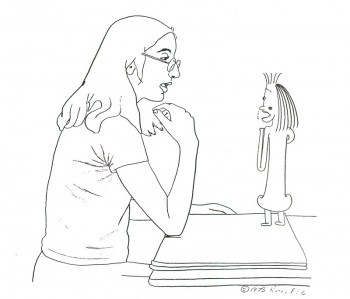 My time at Cal Arts was absolutely magical. Especially because prior to going I had been sequestered, working in an office in N.Y. while I taught myself animation. I saw that Cal Arts had a graduate program in animation, and thought that would be a great way to follow this star. The whole atmosphere at Cal Arts was very exciting – I think it probably still is. Jules Engel was an amazing teacher. He said very little, but when he did, it turned your life around – I am still inspired by his zen style of teaching. The department was small – only around 8 people at the most worked in the animation room, and some worked at home. Adam Beckett worked during the night – at home or in the optical printer room. He and I were in a relationship from 1972-74, and shared a lot about the animation we were working on. Dennis Pies (now Sky David) also worked in his dorm, as did Joyce. But we were all drawn together not just in our department, but with the rest of the Cal Arts community. For awhile I took some dance at the school along with another animator Lisa Rose. (no relation). An animator who was very influential on our group of artists was Jim Gore, who was not a student at Cal Arts. Adam had connected with him and his films. Dream of the Sphinx, and The Letter had a powerful effect on us. It was Jim’s very free, metamorphisizing style – which at the time was a revelation and led to a new way.
My time at Cal Arts was absolutely magical. Especially because prior to going I had been sequestered, working in an office in N.Y. while I taught myself animation. I saw that Cal Arts had a graduate program in animation, and thought that would be a great way to follow this star. The whole atmosphere at Cal Arts was very exciting – I think it probably still is. Jules Engel was an amazing teacher. He said very little, but when he did, it turned your life around – I am still inspired by his zen style of teaching. The department was small – only around 8 people at the most worked in the animation room, and some worked at home. Adam Beckett worked during the night – at home or in the optical printer room. He and I were in a relationship from 1972-74, and shared a lot about the animation we were working on. Dennis Pies (now Sky David) also worked in his dorm, as did Joyce. But we were all drawn together not just in our department, but with the rest of the Cal Arts community. For awhile I took some dance at the school along with another animator Lisa Rose. (no relation). An animator who was very influential on our group of artists was Jim Gore, who was not a student at Cal Arts. Adam had connected with him and his films. Dream of the Sphinx, and The Letter had a powerful effect on us. It was Jim’s very free, metamorphisizing style – which at the time was a revelation and led to a new way.
Q. We came to know you through your early animation work which was all very non-linear. filmically but linear graphically. MIRROR PEOPLE, MOVERS, THE DOODLERS and particularly PENCIL BOOKLINGS all had a large impact on the Independent movement of the late 70s early 80s. Can you speak a bit of this period in your work?
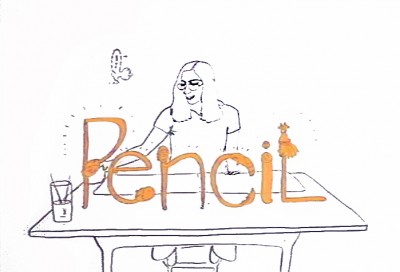 The wonderful input of Jules led me to MIRROR PEOPLE, THE MYSTERIANS, THE ARTS CIRCUS, THE MOON SHOW. I had graduated and was working at Cal Arts while I made The Doodlers, where I used the Cal Arts facilities. PENCIL BOOKLIGS was made in N.Y. with an AFI grant. All these films were the result of my exposure to the fertile atmosphere at Cal Arts, and also my fascination with Yoji Kuri, While I was at Cal Arts, I had started to correspond with Mr. Kuri, and he visited with my family in N.Y. at Thanksgiving. He then came to Cal Arts, and I finally met him. (I even saw him later in 1994 when I was a judge at the Hiroshima Animation Festival, and visited his studio, was taken to dinner (with a translator – Yoji spoke no English).
The wonderful input of Jules led me to MIRROR PEOPLE, THE MYSTERIANS, THE ARTS CIRCUS, THE MOON SHOW. I had graduated and was working at Cal Arts while I made The Doodlers, where I used the Cal Arts facilities. PENCIL BOOKLIGS was made in N.Y. with an AFI grant. All these films were the result of my exposure to the fertile atmosphere at Cal Arts, and also my fascination with Yoji Kuri, While I was at Cal Arts, I had started to correspond with Mr. Kuri, and he visited with my family in N.Y. at Thanksgiving. He then came to Cal Arts, and I finally met him. (I even saw him later in 1994 when I was a judge at the Hiroshima Animation Festival, and visited his studio, was taken to dinner (with a translator – Yoji spoke no English).
Initially, when I first entered Cal Arts, I was sure I did not want to work with narrative, and I said so to Jules, who was very amenable. I also missed the experience of dancing, and the music associated with it, especially rhythms. (I am currently studying Japanese Taiko drumming).
I think both the dance and rhythmical influences are strongly apparent in these Cal Arts pieces.
With PENCIL BOOKLINGS, I was moving in the circle of New York animators and I think although the storyboard was designed pretty early on, I was influenced somewhat by these associations, especially George Griffin‘s TRICKFILM.
Q. PENCIL BOOKLINGS was voted one of the 10 Best Films in the world by the Hiroshima Intl Animation Festival in 1976. You seemed to have reached the top with this animated form and you moved on to the dance/movement videos. Your 1983 film, PRIMITIVE MOVERS, included your dancing with a group of animated dancers, very much in your linear style. Can you speak about what caused your big change – incorporating yourself into the videos.
PENCIL BOOKLINGS was definitely an apex for me, and also left me at a decisive point. After I completed it, my father had passed away, and I had taught as a Visiting Lecturer at Harvard for a year, and I was working for R.O. Blechman on his Soldier’s Tale. I knew only that I didn’t want to return to what I had done, and I was feeling a strong pull to be performing again. But I had never performed solo, and was somewhat lost at what direction to take.
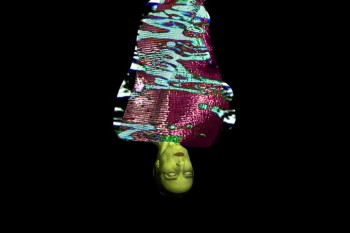 At that point, two things happened. I was living in Tribeca, and one weekend I decided I would just wander in Soho and see where it led me. I ended up at the Bleecker St. Cinema where there was a Marilyn Monroe double bill. This told me I wanted to perform again. (Ironically the first film I remember being taken to as a child was â€Some Like it Hotâ€)
At that point, two things happened. I was living in Tribeca, and one weekend I decided I would just wander in Soho and see where it led me. I ended up at the Bleecker St. Cinema where there was a Marilyn Monroe double bill. This told me I wanted to perform again. (Ironically the first film I remember being taken to as a child was â€Some Like it Hotâ€)
At the same time I received an NEA grant to make an animated film. I decided to mix the two, make an animated film I would dance with. Jules had actually told me almost 10 years before that he could see me dancing with my films. At the time I thought he was crazy, but it demonstrates his intuition. R.O. Blechman also was very encouraging about the idea of combining these. I began taking dance classes again, and ended up studying African dance (for 5 years actually). I was very interested in the Diaghilev productions and his work with set designers for ballet, and in particular the costume designs of Sonia Delauney. In addition, Bob Blechman took the whole studio to see Abel Gance’s Napolean, which was being shown at Radio City Music Hall with a live orchestra – the score by Carmine Coppola. This production was absolutely amazing to me, the effect of the live music on the film made it a dimensional experience, and this was a pivotal moment for me.
I also found seeing Barbara Morgan’s photos of Martha Graham’s PRIMITIVE MYSTERIES clicked for me. Until then I hadn’t really connected with what choreography meant to me. But seeing the stunning, visual, and symbolic group formations in this piece, showed me that dance could be graphic, and this was something I could connect with.
I took a year to produce the animation, and mapped out choregraphy as I drew. Originally I thought I was making a 10-15 minute piece, but it turned out to be 30 minutes. I had a wonderful animation student as an intern – Monica Kendall from Chicago – who worked with me every day. At this time I was also introduced to Mary Bright who I interviewed to design the costume. I knew as soon as I met her at the door, that she was the one. She wore a very big circle earring on only one ear, and that told me everything I needed to know about her dramatic graphic sensibility.
The first performance of PRIMITIVE MOVERS was for a private audience, and it was the most frightening thing I’d ever done. After many performances, I developed my self-confidence and it totally altered me over time.
Q. In PENCIL BOOKLINGS your interplay with your characters came by animating yourself as a character in the film. In PRIMITIVE MOVERS the animated characters and shapes move into your live performance with you as the prime character. Was this part of the goal of the change in direction, or was it part of the result of the change in direction?
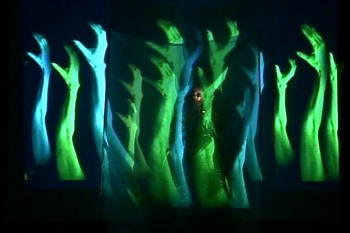 I think in both pieces I am the central character (if you don’t count the pencil). The big difference is that working with projection on something live forces you to work with a very different reality, where everything is not in your control. So many decisions and scenes are the result of the challenges that you meet in integrating the live with the two-dimensional. In PRIMITIVE MOVERS, I basically had to learn to take command, and be the leader, director in my performance itself – it is related to the central role I play in PENCIL BOOKLINGS, but has to be acted out in a much more dramatic way. I often had friends come to rehearsal, and also used a mirror. The input of certain people was key to my development of this genre.
I think in both pieces I am the central character (if you don’t count the pencil). The big difference is that working with projection on something live forces you to work with a very different reality, where everything is not in your control. So many decisions and scenes are the result of the challenges that you meet in integrating the live with the two-dimensional. In PRIMITIVE MOVERS, I basically had to learn to take command, and be the leader, director in my performance itself – it is related to the central role I play in PENCIL BOOKLINGS, but has to be acted out in a much more dramatic way. I often had friends come to rehearsal, and also used a mirror. The input of certain people was key to my development of this genre.
Q. You started projecting shapes onto yourself, essentially acting as the screen for the animation. You make it seem as though the garment, itself, is alive and animated. This with other animated incarnations of yourself moving floating about you.
Unfortunately, I haven’t seen any of your live performances but have watched every video clip I can find. I’m sure I’m missing a lot. I wonder if you can talk about the difference between the live and the video.
It has always been a tremendous challenge to communicate the live event through a basically documentative video. It has actually taken me years to come to terms with it. Some of my early best video recordings were done by Swiss television, of PRIMITIVE MOVERS, and SYNCOPATIONS. I also found when I worked on my 1999 live piece KLEOPAT’RA, I was creating scenes to be used as film clips to run during the performance while I was changing costume off-stage, or to emphasize a stage action, and it allowed me to refine my approach.
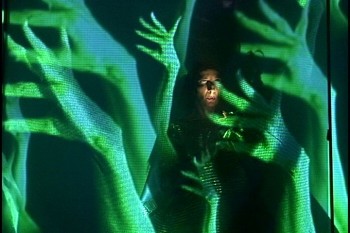 Basically, the live performance of any artist, has an entirely different sense of time from a film or video. In the live event, we are more prepared to wait for what happens because we are there, and there is a suspense, an excitement in the reality of the performer being there, live on the spot. And anything that happens integrating two-dimensional imagery seems impossible, hallucinogenic, and is therefore riveting. In my work it also becomes very sculptural. Often things I thought would be rather ordinary when I shot them as elements, like the floating hair for KLEOPAT’RA (and also QUEEN OF THE FLUIDS – which is a video re-working of the latter piece). When I projected this imagery onto a dancer, I was astounded at the architectural event that ensued. I definitely believe in being open, even waiting like a fisherman, for accidents.
Basically, the live performance of any artist, has an entirely different sense of time from a film or video. In the live event, we are more prepared to wait for what happens because we are there, and there is a suspense, an excitement in the reality of the performer being there, live on the spot. And anything that happens integrating two-dimensional imagery seems impossible, hallucinogenic, and is therefore riveting. In my work it also becomes very sculptural. Often things I thought would be rather ordinary when I shot them as elements, like the floating hair for KLEOPAT’RA (and also QUEEN OF THE FLUIDS – which is a video re-working of the latter piece). When I projected this imagery onto a dancer, I was astounded at the architectural event that ensued. I definitely believe in being open, even waiting like a fisherman, for accidents.
With a video documentation, we tend to assume, in almost a lazy way, that what we are watching is possible, because it is like any other film. But I have found that I can still communicate the design, the theatrical sense in a video document, and of course its wonderful to be able to put these things on the web.
Q. The music throughout your pieces is strong. Do you collaborate with your composers or is it found music (or both)?
I have collaborated with several musicians – C.P. Roth had created rhythms for a piece he was doing for another artist. I heard it when I lived in Tribeca – which was next door to the Franklin Furnace where thie music was playing. I approached him about using the rhythms for SYNCOPATIONS. He also composed wonderful music for my performance piece SHE, which I also used for the later video of the same name.
Walther Giger in Zurich composed some really great music for me – I used one piece for my performance KABUKIMENKO, and a scene from it for a later video of the same name. I was studying flamenco and he has worked with Spanish guitar so it was a great fit.
Toshi Makaihara created sound for KLEOPAT’RA, and I was permanently affected by that creative experience. It drew me into the idea of pure sound, and since then I have made most of my tracks using sound from objects, instruments I recorded myself.
Toshi has come to my classes at The University of the Arts, where I have taught a number of courses, most lengthily Image and Performance, an interdisciplinary workshop. He completed charmed the class by playing every object in the roon.
Q. The lively and strong video SYNCOPATIONS has you dancing about projected mirror images of yourself. All the while images are projected onto yourself. The costumes are so vivid that it leads one to believe that the video is making a statement about fashion. I watch the very dark shadow of the live you falling onto the screen images of yourself and noticing the strong blacks against the strong luminescent white of your live gown. It’s a stirring video. Any comments about this piece?
The integration of the costume with the film projections (it was film then) was very carefully planned. The use of white and black (which is even more important in earlier scenes of this 50 minute piece) were absolutely key to the designing.. I worked with several dancers, having them come to my loft every week, and prepared choreography for them based on a rough storyboard I had made. Sometimes I shot a film test of their movements. There were seven scenes of which only two are seen on line currently. When I felt the choreography for a section was working, I shot Polaroids (this was 1985-7) and created a storyboard from those, which I was able to use for the dancers, and cameraman at the final shoot. We had several shoots, over a year or two.
My assistant cameraman, Roger Grange was extremely helpful and competent and I worked with him in subsequent years, especially on KLEOPAT’RA.
When the film was completed of the dancers, I rehearsed, using a mirror, and choreographed my movements for the live on stage component. The piece was meant to convey the whole idea of syncopations, rhythms, both our generic idea of speed in rhythms, but also of the hidden and inner rhythmical universal pulse beyond the obvious. It was about visual rhythm in the form of patterns too, in addition to the aural interpretation.
I was very influenced by some early modern dance, espedially in Germany – a number of those dancers had used scarves for interpretative dancing.
The premiere was in Santa Fe, at the Contemporary Art Center. I traveled with a simple costume case into which all the costumes went, including the hoop. People were amazed after the shows when I would return this entire magical illusion into a simple 3’’x3’ case.
And I should also mention that all during the time I was doing these performances, from 1983, no-one had really seen anything like this before. Later, when I was teaching I discovered a wonderful piece by Robert Whitman called Prune Flat (1965), which was closest to what I had done.
But my use of animation, and then live action in this very precise way with the live performer, explored so thoroughly was a very exotic bird, and I had a lot of press with this work.
Q. In QUEEN OF THE FLUIDS it would seem that an Oriental goddess gives birth to liquid/smoky characters that float about you. At one point you make yourself the screen as black tears run down your face while liquid characters dance around your head. The imagery is beautiful and the non-linear story (though I’ve only seen the short excerpts on our site) is deep. Can you speak of this film and the impetus behind it.
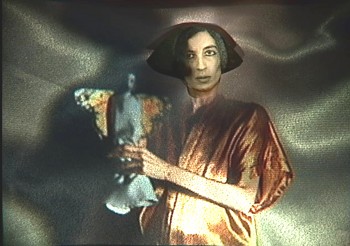 QUEEN OF THE FLUIDS (2003) , which was done with a Guggenheim Fellowship in Performance Art, was a chance to create a video using elements and scenes from my live performance – KLEOPAT’RA,(1999) which I had worked on for 5 years. The narrative differed. In KLEOPAT’RA, it opened with the formation of a statue In film clips (shown while I lay on the ground hidden in a gold pleated fabric), gold dripped into the body, the eyes dripped on, etc. Then a series of scenes followed with an imaginary landscape of the queen. I was integrating Egyptology and Japanese aesthetic.
QUEEN OF THE FLUIDS (2003) , which was done with a Guggenheim Fellowship in Performance Art, was a chance to create a video using elements and scenes from my live performance – KLEOPAT’RA,(1999) which I had worked on for 5 years. The narrative differed. In KLEOPAT’RA, it opened with the formation of a statue In film clips (shown while I lay on the ground hidden in a gold pleated fabric), gold dripped into the body, the eyes dripped on, etc. Then a series of scenes followed with an imaginary landscape of the queen. I was integrating Egyptology and Japanese aesthetic.
At the end, the gold dripped out, the eyes emptied, and the figure was left vacant, empty, ready for transport to the other side. There was then a large pyramid, projected onto a veil, into which she entered signifying her passage from the real world. This piece was generated by my witnessing at her bedside, of my mother’s passing. It was an experience that changed me forever, and which I can never forget. In fact the piece She (the original theatrical work) was also a result of this.
My description of QUEEN OF THE FLUIDS says:
“Through rain falling backwards a golden queenly being rises up. In a poetic introductory scene, the gold drips out of her body, and her eyes are shed. Entering through the eerily empty orbs into her brain, we discover a metaphysical kingdom – a world of liquidity, and are led through the mind into an “under-realityâ€,arriving in the pure abstraction of consciousness. Finally, in “The Recovery of the Bodyâ€, her physical self is re-constructed, leading to “The Other Side of The Tapestryâ€, in which we arrive at a kind of “uber-surrealist†view of the artist and the symbolic mirror of herself.â€
This video represents a culiminating point in my performance generated imagery, and my first single channel video.
This piece is also influenced by such sources as the Futurist painter Boccioni’s “states of mind†drawings, bunjin-ga – the symbolic landscapes of Japanese art, and a fascination with puppetry and dolls.
I should also mention re your observation about cgi, that there is something about the reality of the actual projection (it was film) on the face, with the dripping eye scenes that makes it more magical. We were not doing it digitally, but in reality – the body was collaborating with the projection, and this makes it more “unbelievableâ€. One shot actually took 2 years because everytime we tried it, the two would not work together.
Q. Once again, in THE CATHEDRAL OF EMPTINESS, you turn to the oriental art playing off Bunraku puppets with the hand itself acting as a host of puppets moving around the screen. You perform wearing the beautiful white mask. It’s a strong film that clearly shows your love of the medium. Could you give us a few details about the creation of this piece?
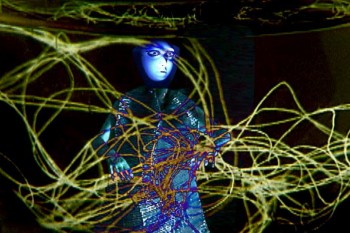 I do love this piece, and feel good performing it because it is really quite natural and organic in its structure. It does not require a lot of precise manipulation of props, costumes, etc. like the other performance works. The actual live performance uses the gold mask from QUEEN OF THE FLUIDS, because it turned out to be very easy to use, and is quite beautiful. I started out thinking I would
I do love this piece, and feel good performing it because it is really quite natural and organic in its structure. It does not require a lot of precise manipulation of props, costumes, etc. like the other performance works. The actual live performance uses the gold mask from QUEEN OF THE FLUIDS, because it turned out to be very easy to use, and is quite beautiful. I started out thinking I would
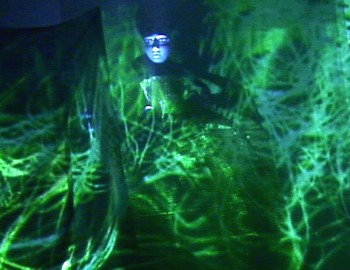 be making a performance version of my video THE INN OF FLOATING IMAGERY. This transformed a great deal, and I shot new scenes, including the trees (branches from our backyard), and the falling “petals†(paper strips that I cut in a form to extend their flight), etc.
be making a performance version of my video THE INN OF FLOATING IMAGERY. This transformed a great deal, and I shot new scenes, including the trees (branches from our backyard), and the falling “petals†(paper strips that I cut in a form to extend their flight), etc.
I also used a koto that my father had bought many years ago at Bloomingdales I think. The sound was constructed by me from this and other elements.
The title comes from an article I read in the NY Times by a reporter – who wrote that the bombing in Bosnia had left a church as an empty shell, like a “cathedral of emptinessâ€. I am very afraid of thunder, but enjoy having lightneing flashes and thunderous sounds in my work.
Q. You’ve obviously moved away from the characters in your films and have shifted to shapes, effects, textures and lighting. This is an interesting evolution and wonder if you’d care to comment?
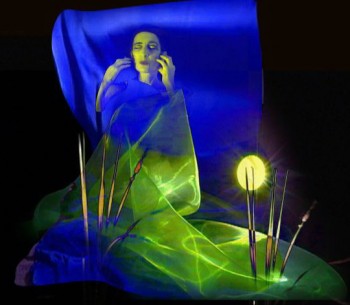 This is a very natural progression really. I feel that if you are not frightened occasionally by something you are making, then you are not advancing. I think there is definitely a big change from the early animation, to Pencil Booklings, Then in Primitive Movers I noticed the characters/figures seemed to become older, less childlike, which I took as a psychological and artistic advancement.
This is a very natural progression really. I feel that if you are not frightened occasionally by something you are making, then you are not advancing. I think there is definitely a big change from the early animation, to Pencil Booklings, Then in Primitive Movers I noticed the characters/figures seemed to become older, less childlike, which I took as a psychological and artistic advancement.
Each piece led me further and further along, and I find that abstraction I made in some of the performance pieces interests me by itself as well. More and more, I am influenced by the Japanese aesthetic, and my current project THE METAPHYSICAL PAINTINGS (a video) features mostly asian faces – quite often students of mine.
I also spent some time away from animation in the early 1990’s, working with only choregraphy and lighting design. The daunting precision of working with projections got to me and I needed a rest. I returned from this by doing Oriental Interplay.
Q. Where do you hope to go with future pieces?
I expect to continue to make videos, and performances. It is not really possible to predict what they will be, as the work changes by itself, and I follow it.
However I am also finding I am interested in creating projection design for other directors for theatrical, and dance productions, as well as for architect/designers.
I have also created some really beautiful installation pieces, and carrying out work like this, or projection design for architecture would make me very happy, because then I can see the work myself and enjoy the dimensionality.
Q. I know your website offers dates of your upcoming performances. Do you have any specific performances upcoming that you’d like to note? Do you find that booking performances is easier/harder/just different to navigate than the early days of sending out films to festivals?
Booking performances was always a lot of work – I had an agent in Europe for a while who got me a lot of work there, and I moved to Zurich for a while. I do find it is much more difficult now, largely because the economy is so bad. I performed for museums, film and dance festivals, universities, etc. (Performed for the Hiroshima Aniimation Festival, Cardiff Animation Festival, etc.)
I have kept up performances, and have exhibited my videos extensively in dance video festivals – which seem to be very open to a liberal interpretation of movement in media.
Of course the wonderful thing now is you can promote what you do easily. I used to cart around giant film cans for performances, and vhs tapes, even dvds would pile up as demo samples. Now we can send flyers in a paperless environment, and with one click, send people to websites with video clips.
Q. Do you have any thoughts about the current state of animation you’d like to share?
The web is really amazing because you can see all kinds of really unusual work. This is very good for animation, and really any kind of expressive video-making. I find when I teach, more and more, I show my classes things from the web, and they show me work also.
I think the whole thing has resulted in a very creative, positive exchange. It is probably very healthy and nourishing for artists of all genres. And probably there is less of a categorization – on sites like vimeo you can see any kind of really progressive interesting work, some animation, or film graphics, or installation related projection. It is a challenge to us all, but is a positive environment.
Early animation
“Syncopations” excerpt
Go here to see more samples of Kathy Rose‘s performance/animation samples.
Animation &Disney &Frame Grabs &Layout & Design 20 Jun 2011 06:56 am
Pinocchio – Multiplane
- In highlighting the use of the multiplane camera in Disney’s animated films, the pinnacle has to be Pinocchio. Two specific scenes jump out in any mention of the multiplane camera: the move in to Gepetto’s workshop and the awakening of the village.
So let’s get right into it:
Sequence director: Ham Luske
Layout by Hugh Hennesy
Animated by “Music Room 2″
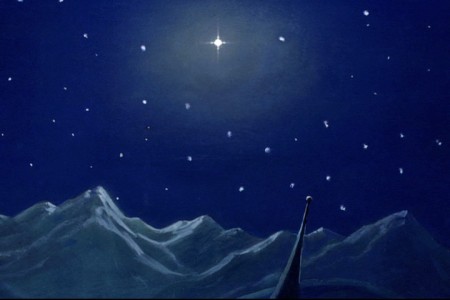 1
1Start in the sky with the wishing star that will play
a large part in the film in a couple of moments.
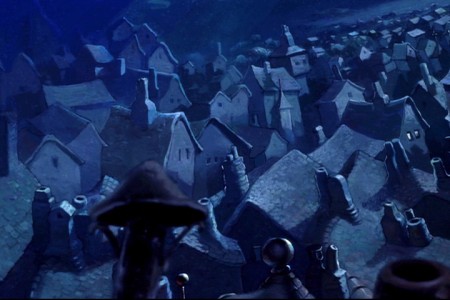 2
2
Circle down from the sky field to an overhead of the village.
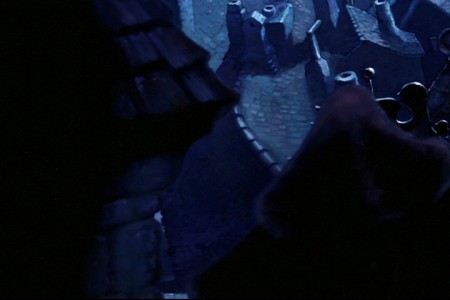 3
3
Continue moving down over the rooftops.
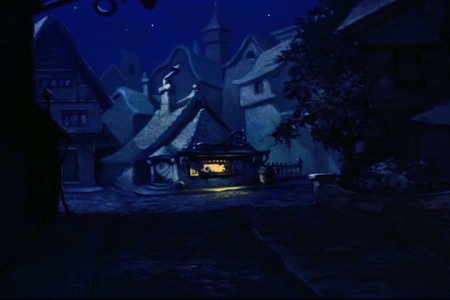 5
5
We first see Gepetto’s workshop from a distance.
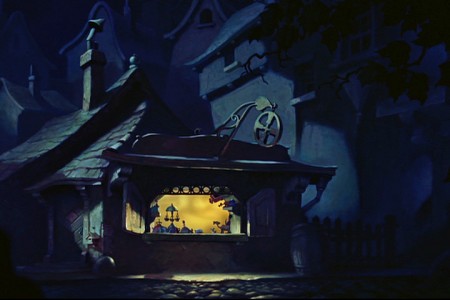 6
6
There’s a matching cut and we continue to move in.
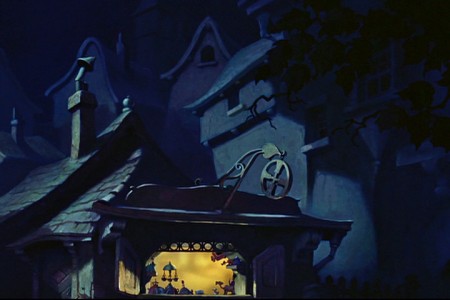 7
7
The POV of the camera is through Jiminy’s eyes.
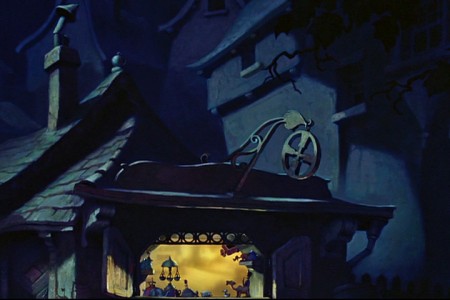 8
8
When he moves in, it’s in hops.
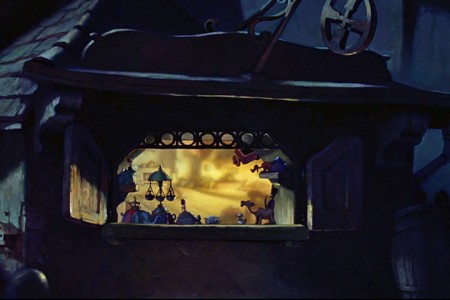 10
10
Leaps and bounds as he (through our camera’s eye) gets closer.
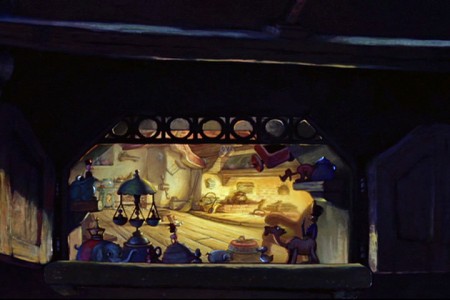 12
12
The warm window into the workshop begins to fill the screen.
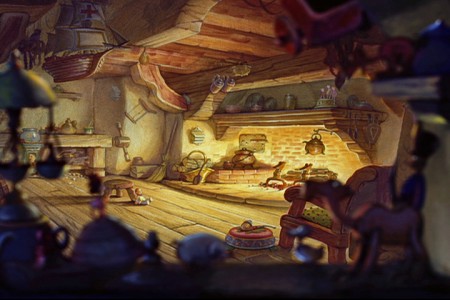 15
15
. . . looking into the workshop through the window.
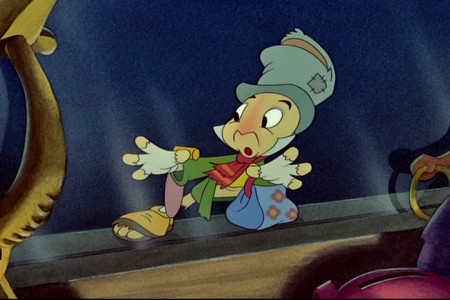 16
16
Cut to an interior shot – the interior side of the window.
Jiminy Crickey, with hands and face up to the glass.
Then we move onto a miracle of a shot that would be hard even for computer users. Today, we wouldn’t anchor the feet properly on all those kids walking and running about. It’s an amazing piece of animation history.
The sequence director was Wilfred (“Jaxon”) Jackson.
Layout by Thorington C. “Thor” Putnam.
The animators involved in this scene include: John McManus, Jack Campbell, Cornett Wood, John Reed, Art Babbitt, Milt Kahl, Don Lusk, and Sandy Strother.
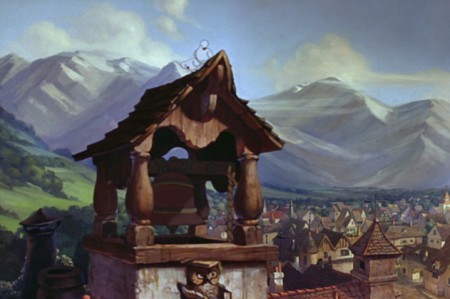 1
1The camera starts at the bell tower over the sleeping village.
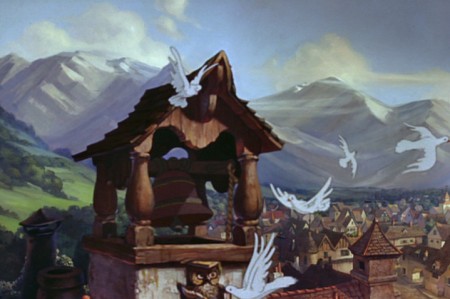 2
2
Doves fly out as the bell starts to chime.
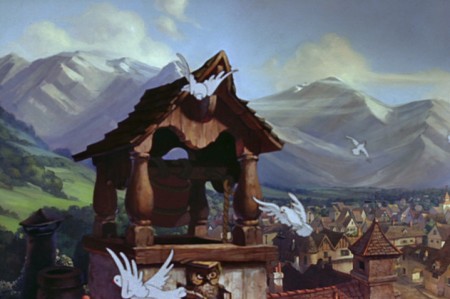 3
3
The birds fly out of focus as they move forward.
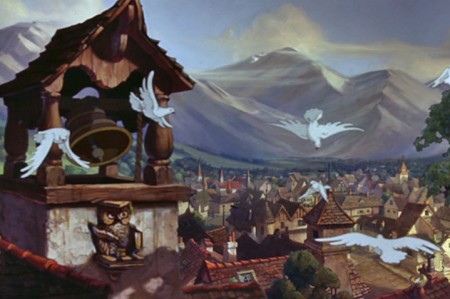 4
4
This allows the camera to start the big move
with the birds covering the tower.
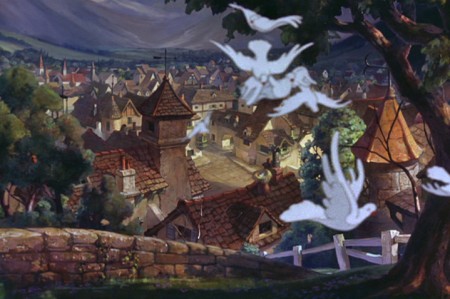 6
6
The camera pushes in to cross the
little footbridge to enter the town.
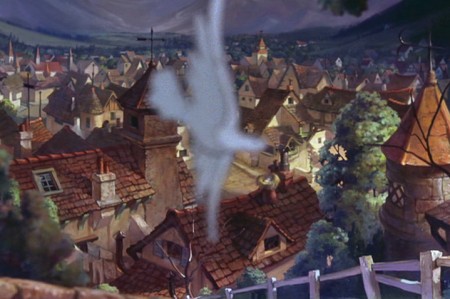 7
7
The last bird leaves us, and . . .
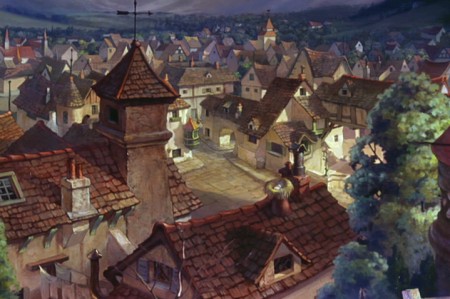 8
8
. . . we’re into the village.
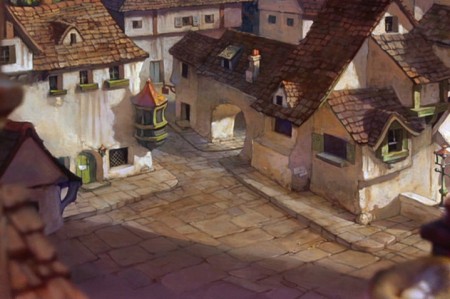 10
10
We move in toward the cross section of the town . . .
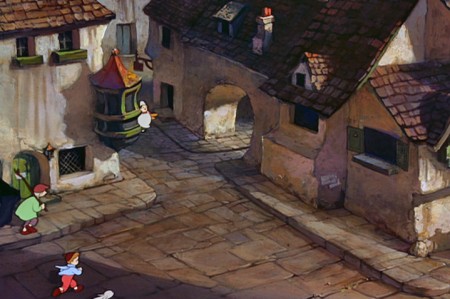 11
11
. . . as people start to come out of their houses.
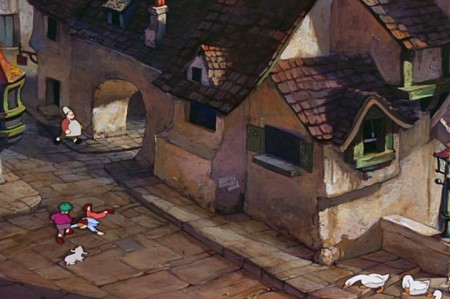 12
12
The camera moves to the right.
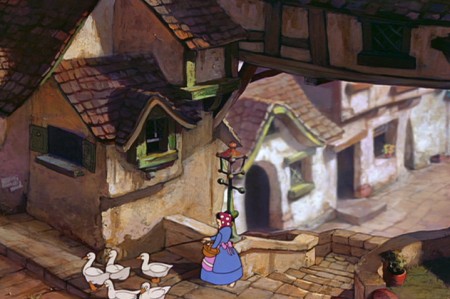 13
13
We move toward a woman with geese as the
camera goes under an overpass.
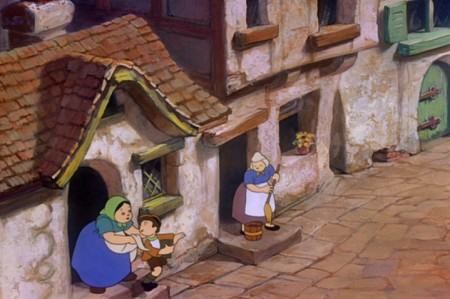 15
15
We head a few steps down as more
chldren come out running to school.
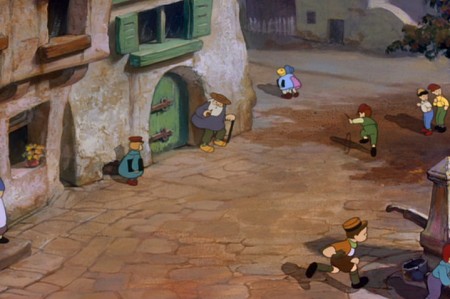 17
17
The camera continues to the right
seemingly led there by one running boy.
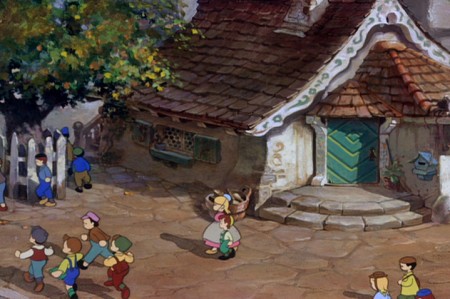 19
19
. . . reaching Gepetto’s house.
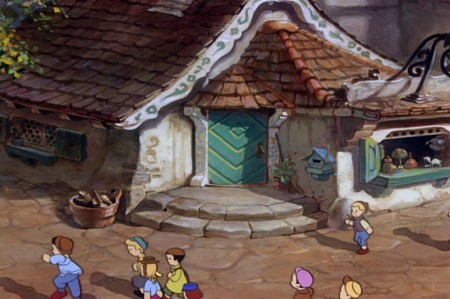 20
20
The camera moves in on the house.
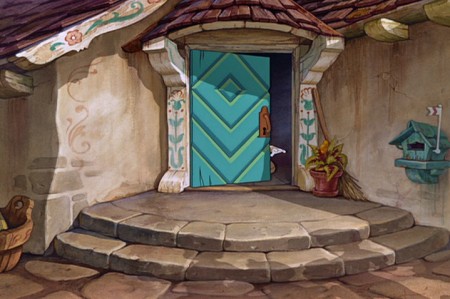 21
21
At this time we cut in and the big-time animators take over.
Milt Kahl handles Pinocchio, Art Babbitt does Gepetto, Don Lusk animates Figaro.
Although there are numerous beautiful scenes from Pinocchio that employ the multiplane camera, there’s one last sequence I’d like to concentrate on. This is where J. Worthington Foulfellow (“Fox”) and Gideon the cat cajole Pinocchio into following them so that they can sell him to the puppetmaster, Stromboli. This is a particularly interesting scene for the multiplane camera.
The sequence director was T. Hee.
Layout by Ken O’Connor.
The animators involved in this scene include: Ugo D’Orsi, Jack Campbell, Hugh Fraser, Charles Nichols, Marvin Woodward, Preston Blair, Milt Kahl and Charles Otterstrom and
Phil Duncan.
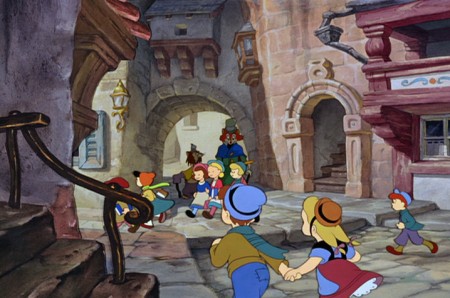 1
1The multiplane camera scene is several away from this,
but I feel as though this scene really sets up the big one.
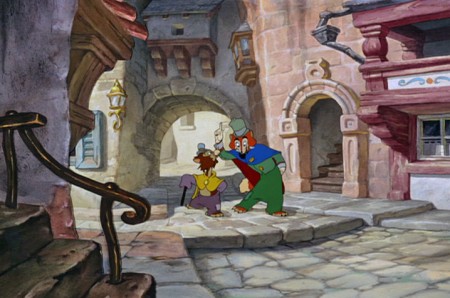 2
2
We properly meet the fox and cat as they walk through the town.
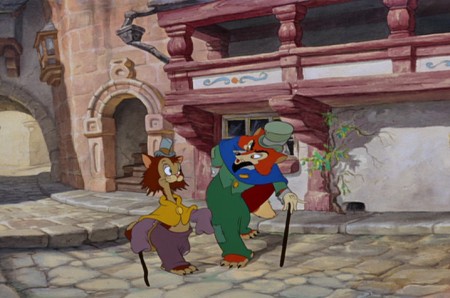 3
3
They are well into conversation.
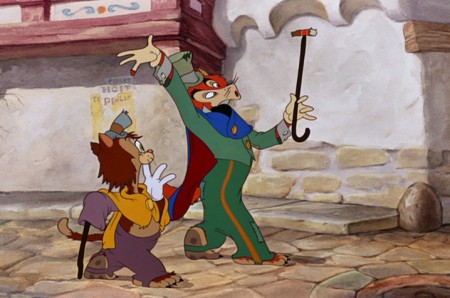 5
5
The fox picks up a cigar stub, telling us about their financial state.
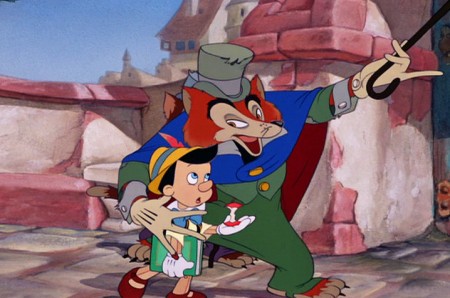 7
7
Several short scenes later, they run into Pinocchio and
coax him away from school to follow them to the theater.
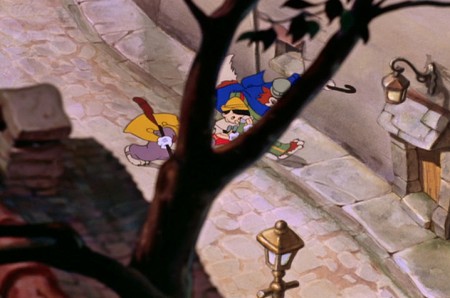 9
9
This cuts into the overhead multiplane shot.
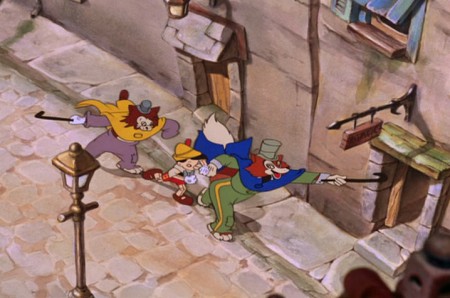 11
11
We watch from overhead with trees and ornaments
marginally blocking our vision of the characters.
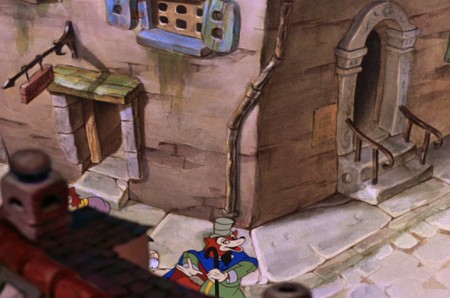 13
13
They turn a corner and the camera follows them.
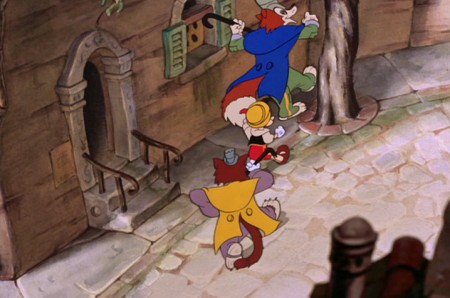 17
17
A quick circling of the tree.
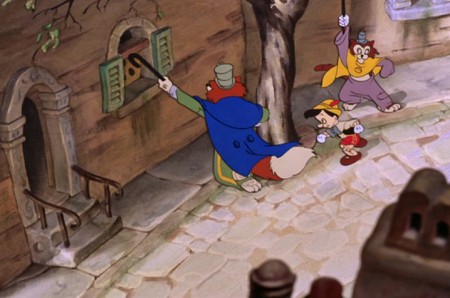 19
19
They do it again, but . . .
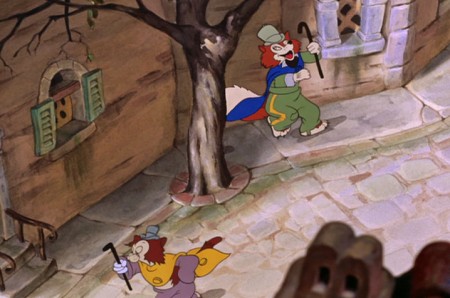 20
20
. . . Gideon the cat continues forward moving off screen.
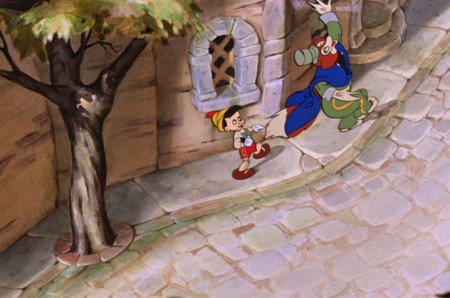 21
21
The fox and Pinocchio continue on the path.
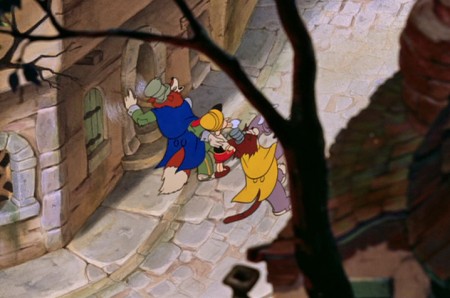 23
23
. . . catching up with them.
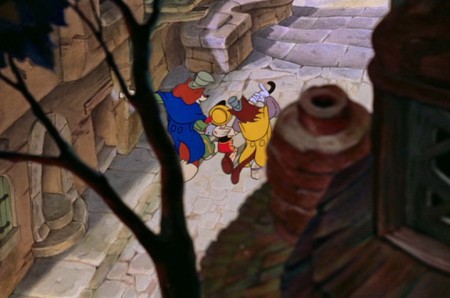 24
24
We view them through a tree and the side of a building.
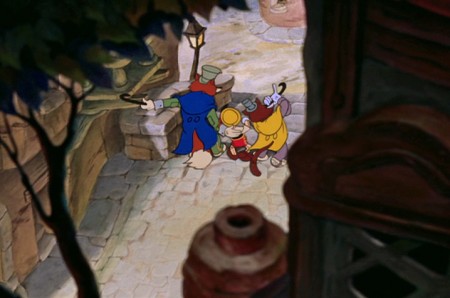 25
25
They go up several steps, but the camera stops.
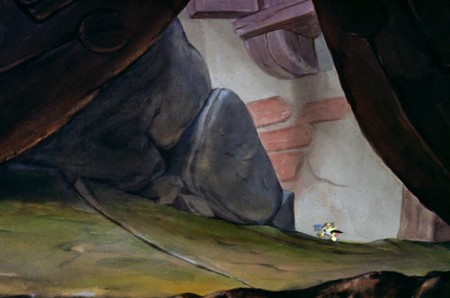 28
28
. . . the next scene, Jiminy Cricket is running. He’s late trying
to catch up to Pinocchio, thinking he’s on the way to school.
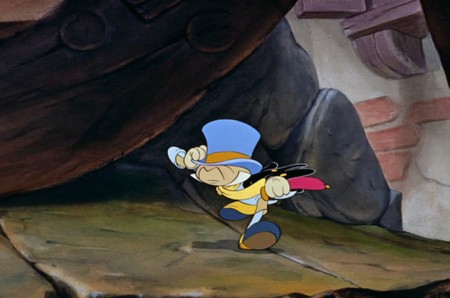 29
29
Jiminy is animated here by Phil Duncan.
David Nethery correctly points out in the comment section,
that Milt Kahl animated this scene.
Animation &Animation Artifacts 15 Jun 2011 07:19 am
DeMattia’s Tubby
- Not every animated film is good, nor do they have good animation. But there’s usually a preponderance of workmanlike animation done for these films. Tubby the Tuba is a dog that was produced by my alma mater, New York Institute of Technology. Alexander Schure was the head of the school, and he brought it from Manhattan to Old Westbury, Long Island. He was an animation buff and wanted to be the next Walt Disney. He used his money to build an animation studio working out of his college. The studio ran through a number of heads from Sam Singer (Courageous Cat) to Alexander Schure, himself. Johnny Gentilella ultimately became the director of the project. The film took a couple of years to make with a lot of “B” animators, many of them culled from Los Angeles.
A footnote on the school was that Schure ultimately invested in some early computer animation, and though he was determined to compete with Saturday morning, limited animation quality via the computer, he financed some of the future cgi developers for animation including Ed Catmull, Ed Emschwiller and Alvy Ray Smith.
Ed DeMattia was an animator on Tubby the Tuba who did a number of scenes. I pulled one of them to give an idea of his animation. It’s surely not something worthy of study.
Since some of the drawings are just mouths calling for TraceBacks, I don’t post most of those.
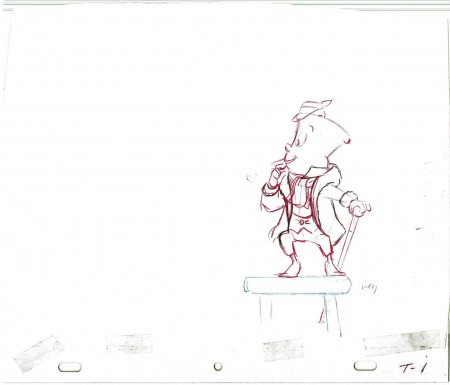 1
1
________________________
.
The following is a QT of the entire scene with all the drawings included.
Since I didn’t have exposure sheets, I calculated everything on twos but
since there were only every other drawing most of the action is on fours here.
Animation &Hubley &Tissa David 01 Jun 2011 08:18 am
Tissa’s VIVA
- Tissa David animated a VIVA paper towel spot for the John Hubley. I have most of the drawings for the commercial. Here’s a scene wherein the lead, a woman, walks through (Bg pans behind her at .25 per drawing) toward the kitchen, where she stops.
Instead of giving you the entire page of animation paper, I’ve trimmed it down to just include the character and her walk. Here are four examples of what the entire drawing looks like, untrimmed.
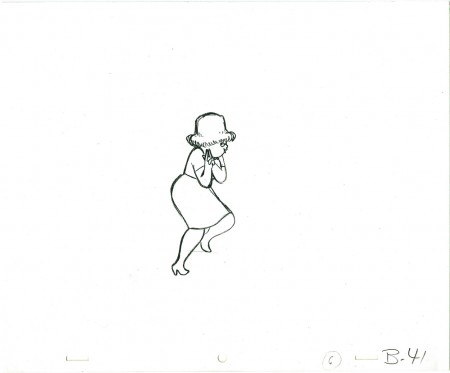 B41
B41
And here are all the drawings for the scene cropped:
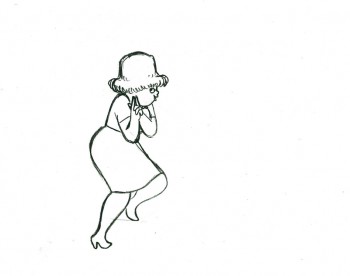 41
41
________________________
.
The following is a QT of the entire scene with all the drawings included.
Since I didn’t have exposure sheets, I put everything on two’s straight ahead.
